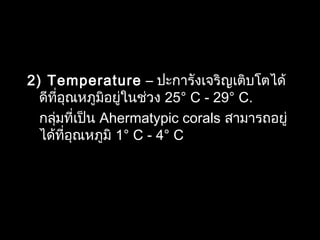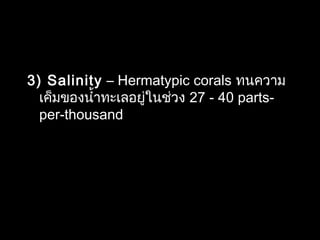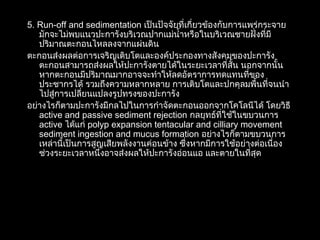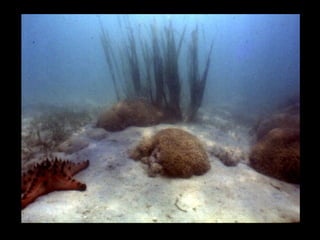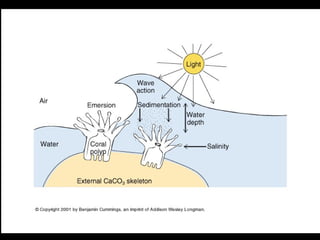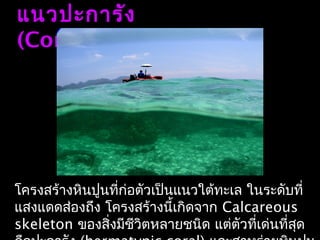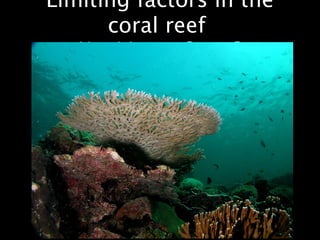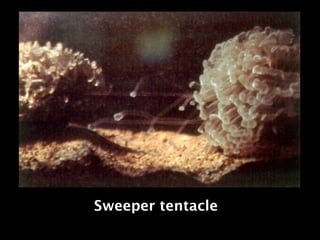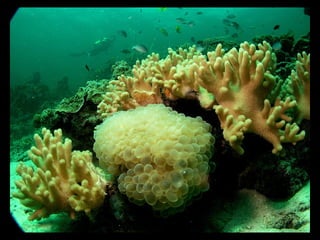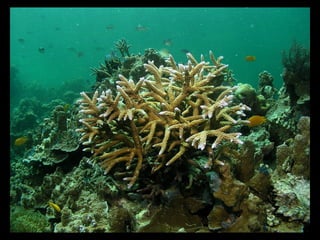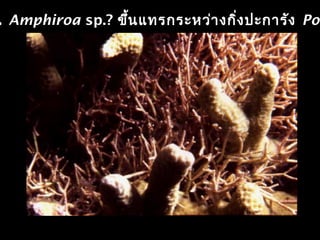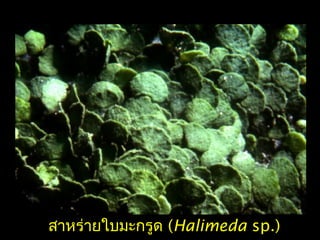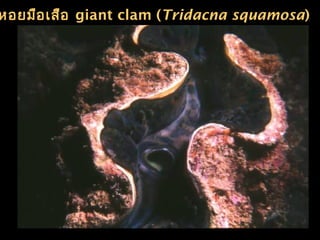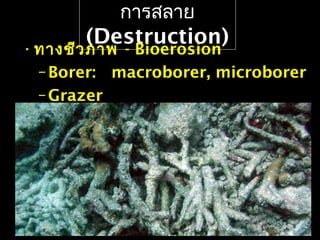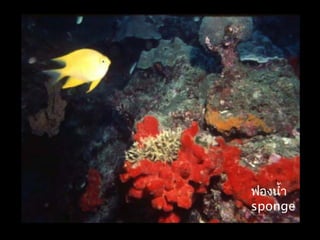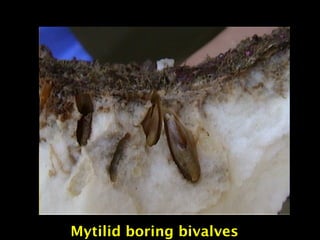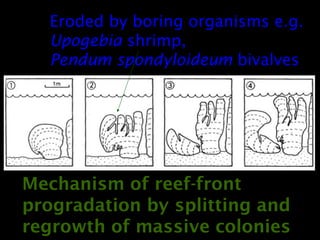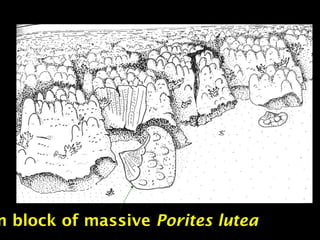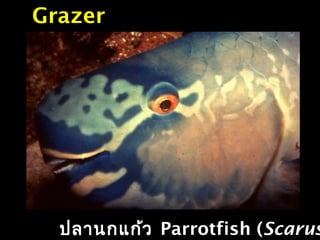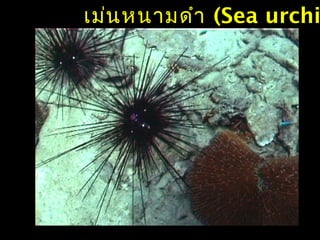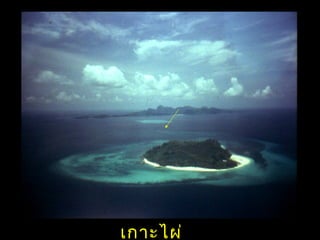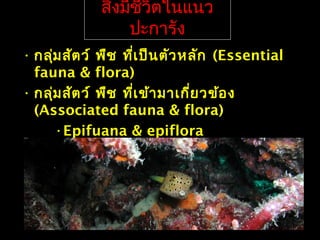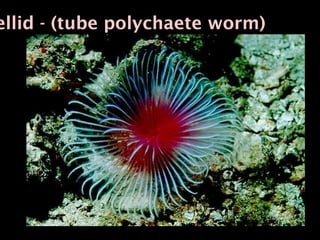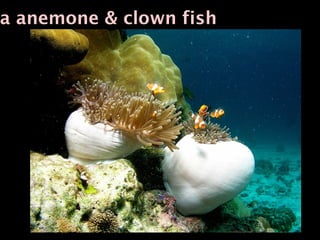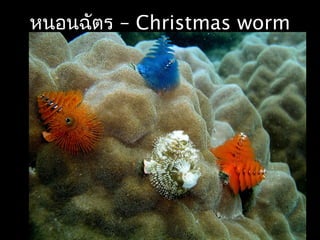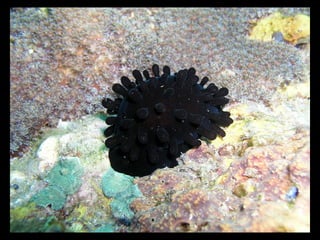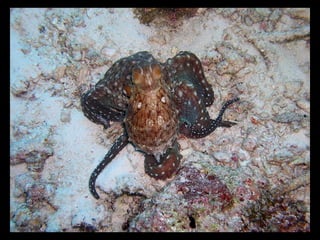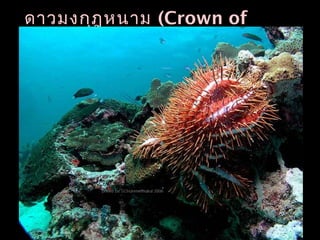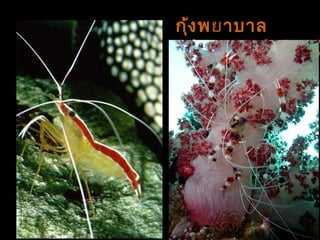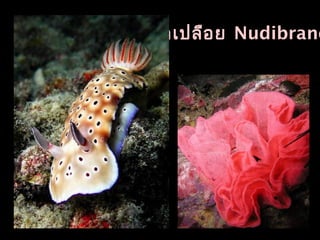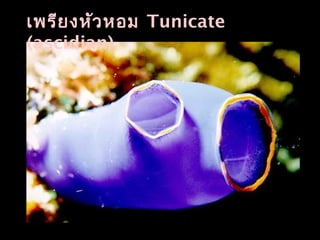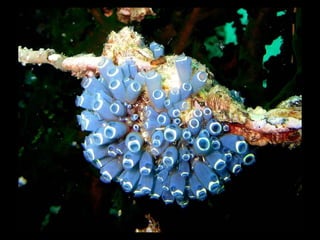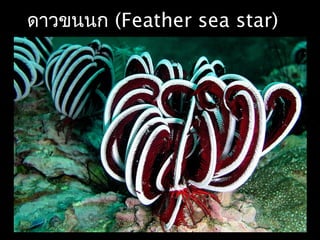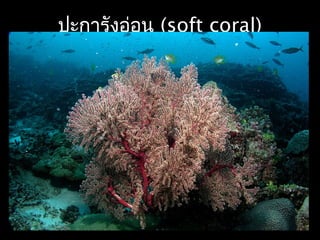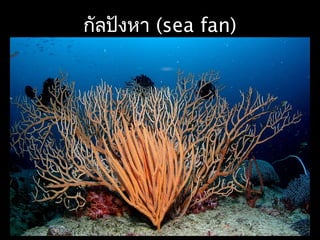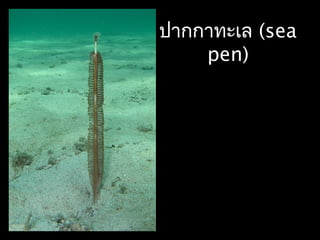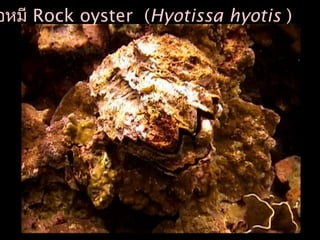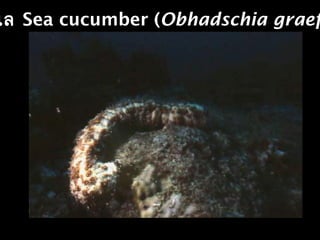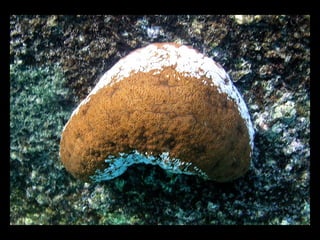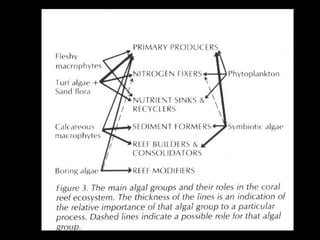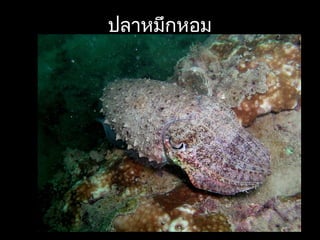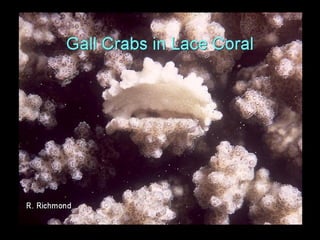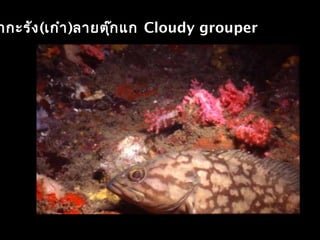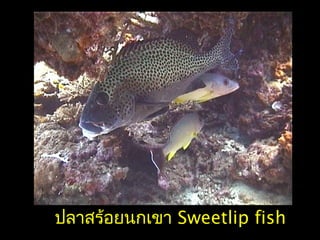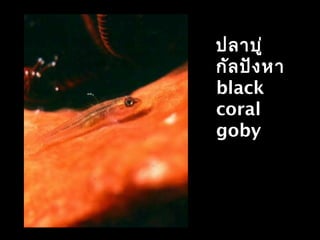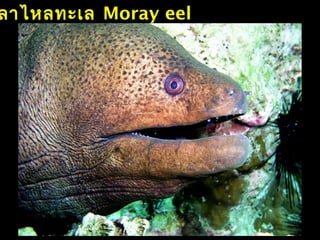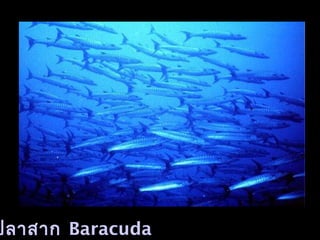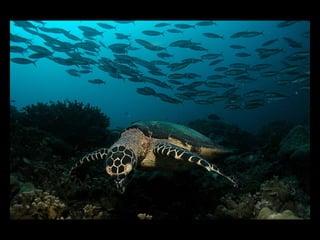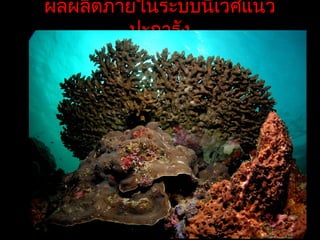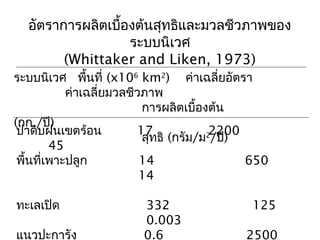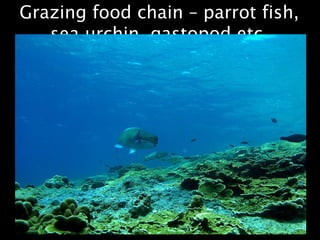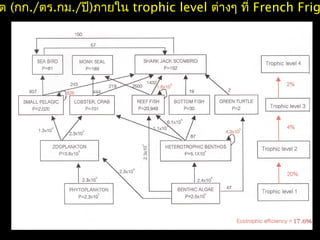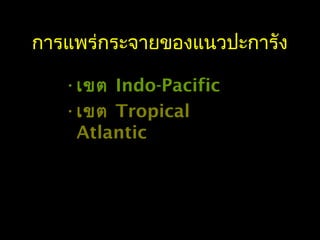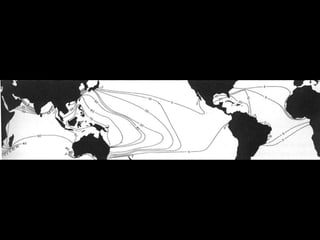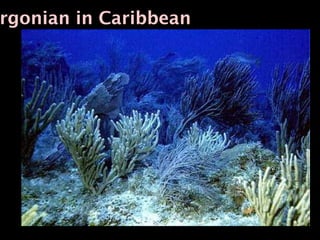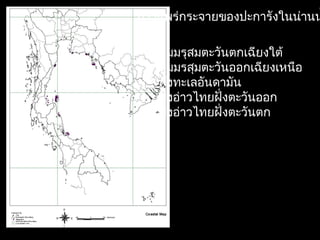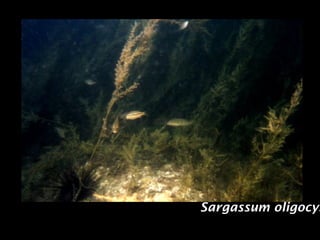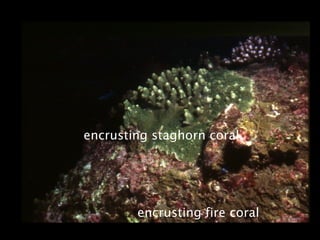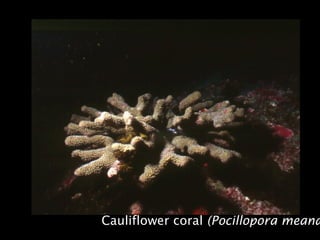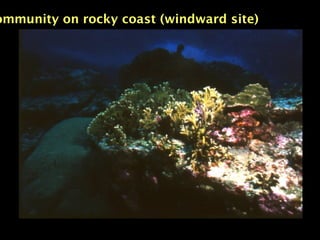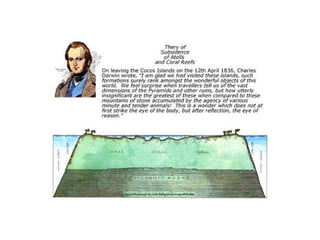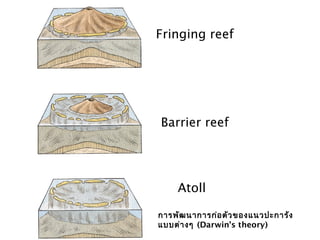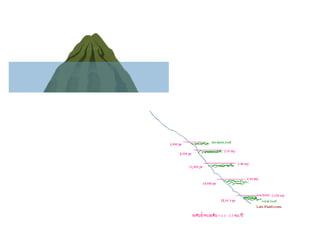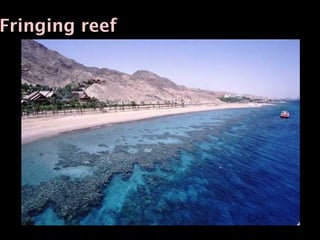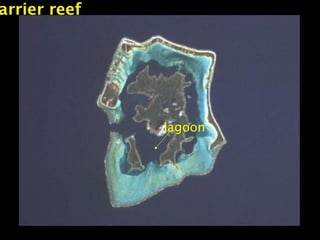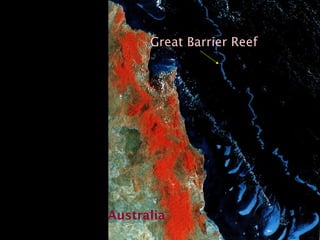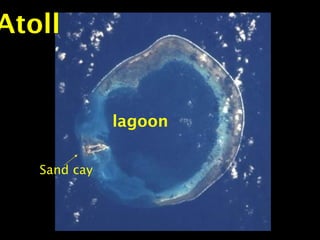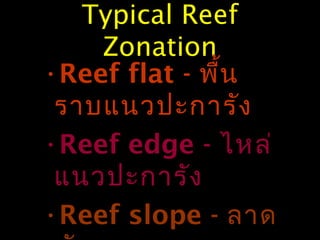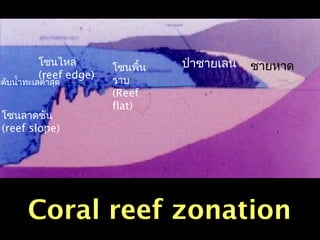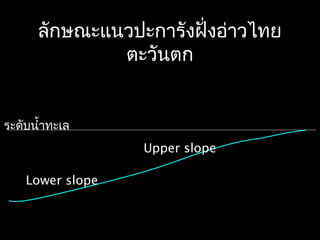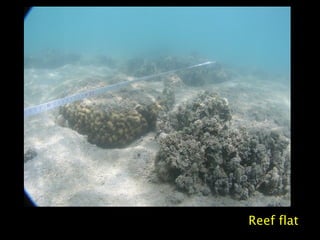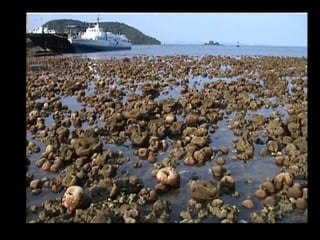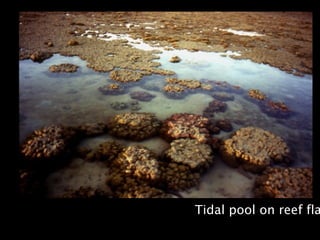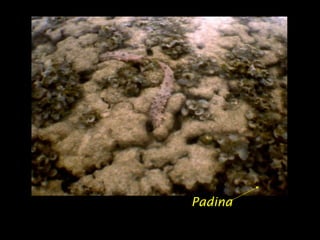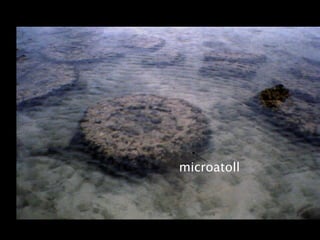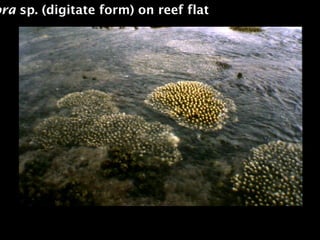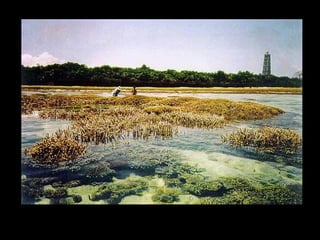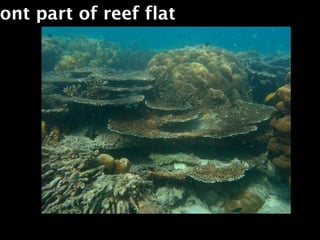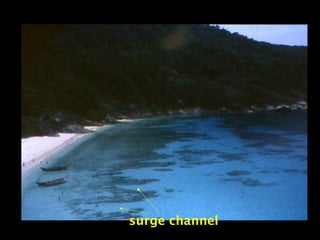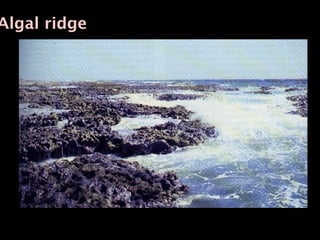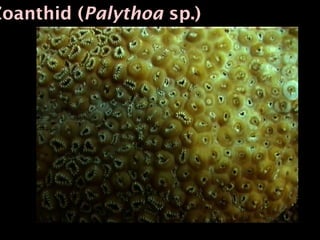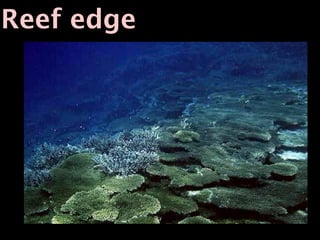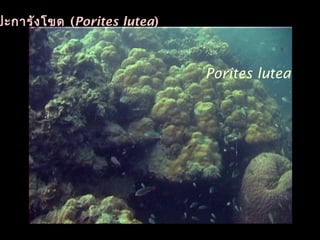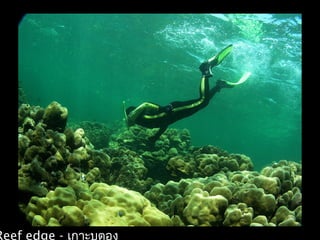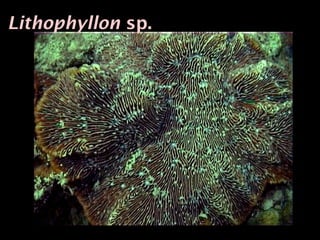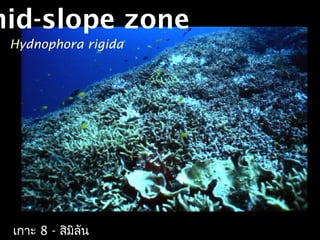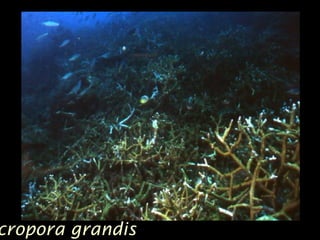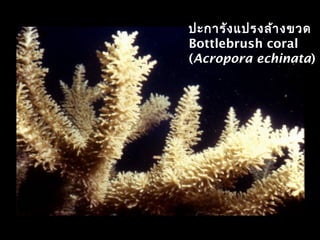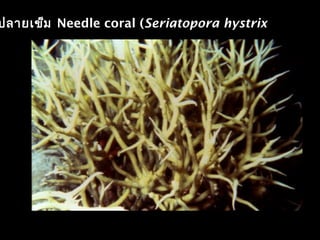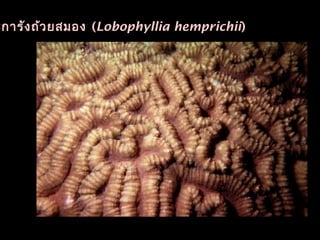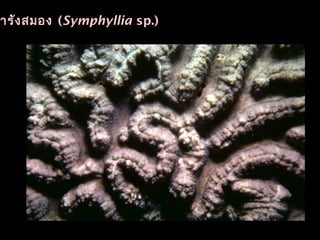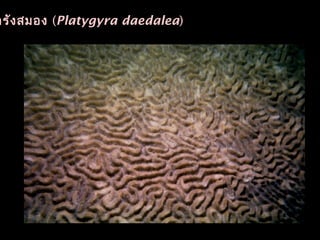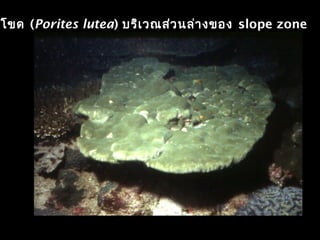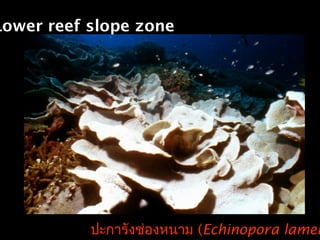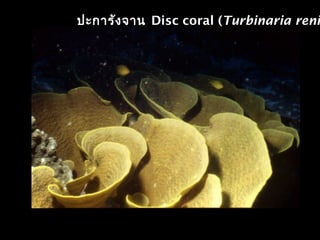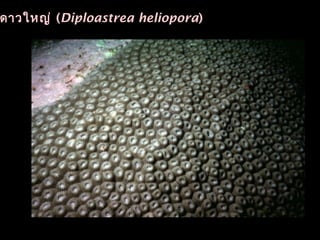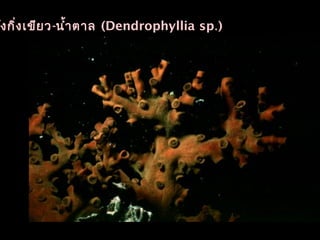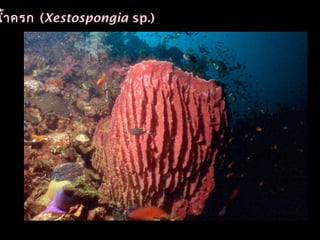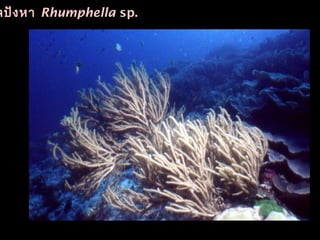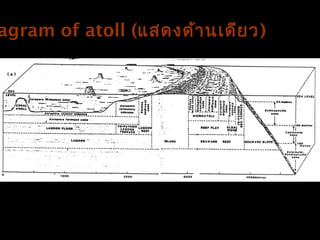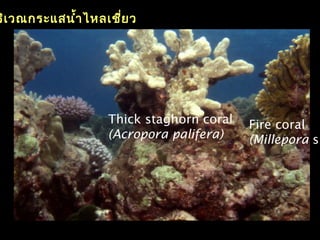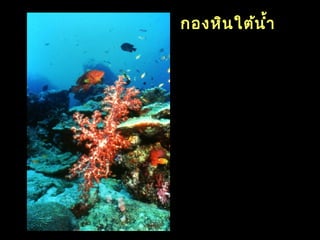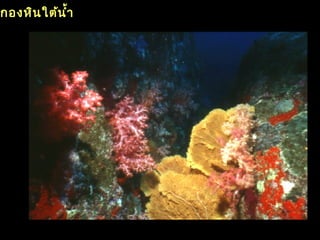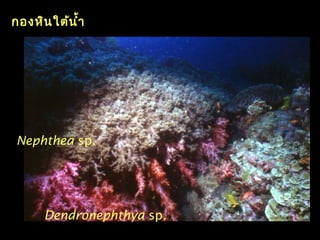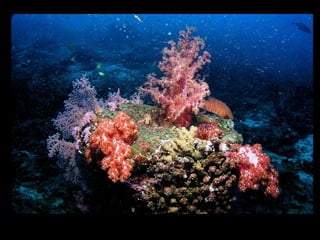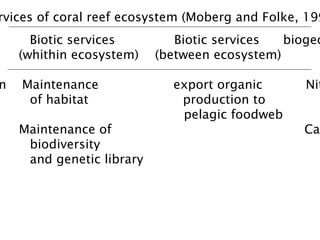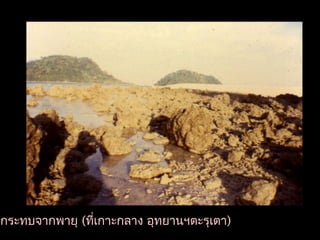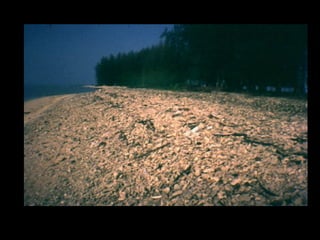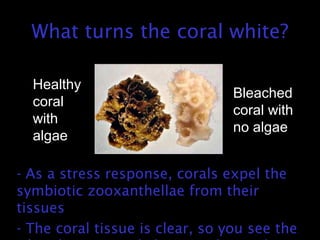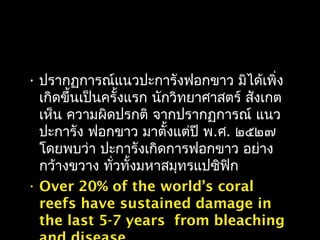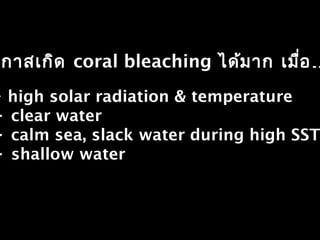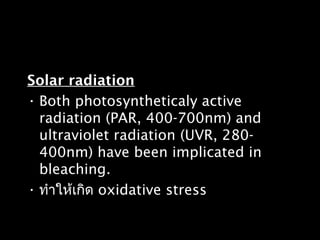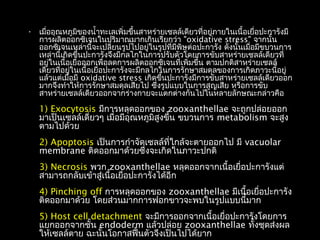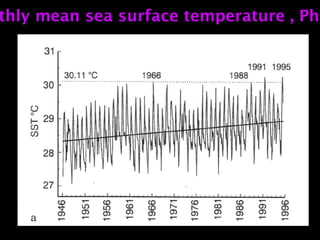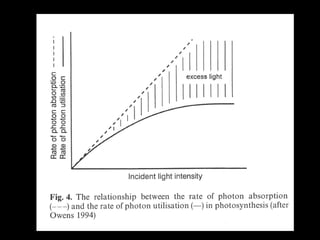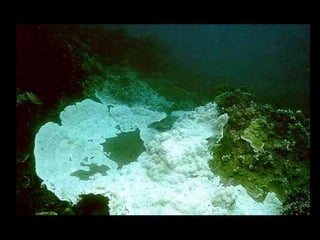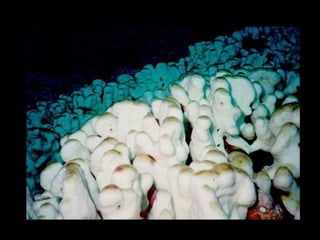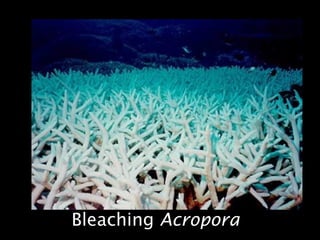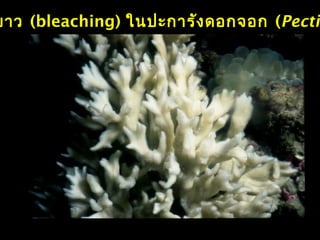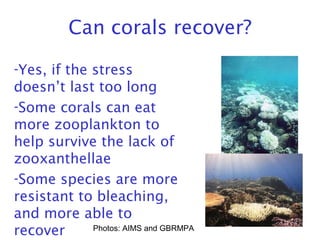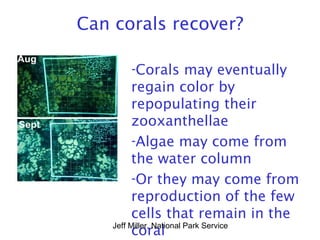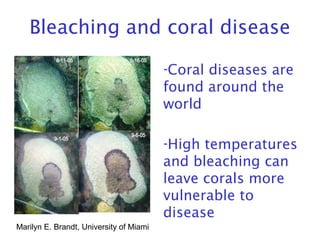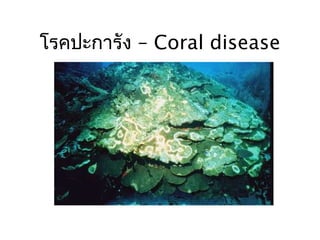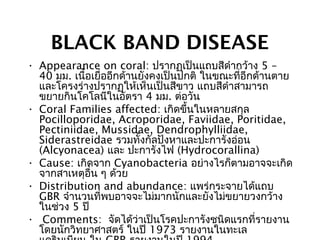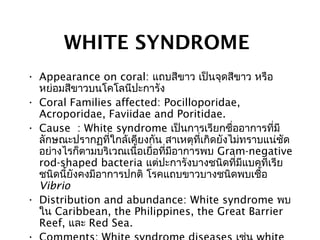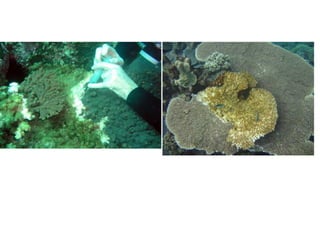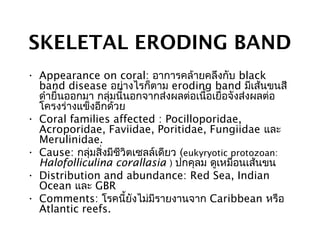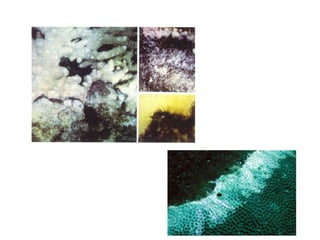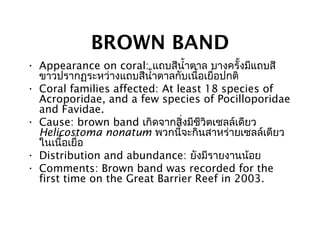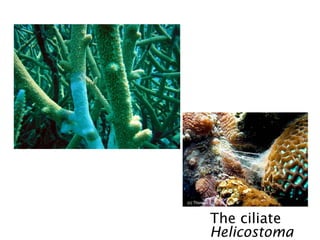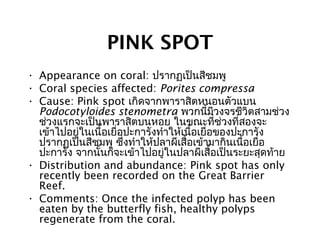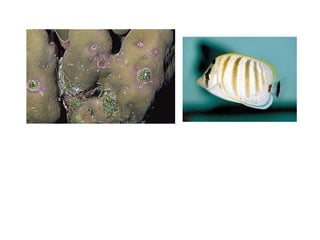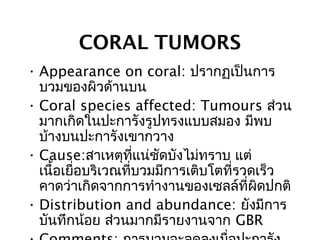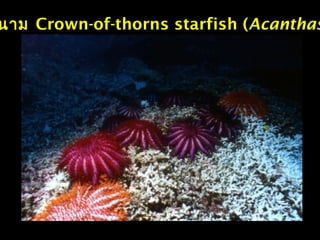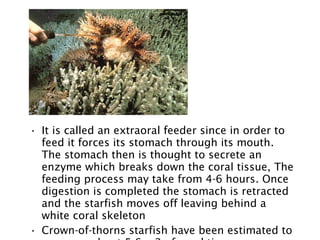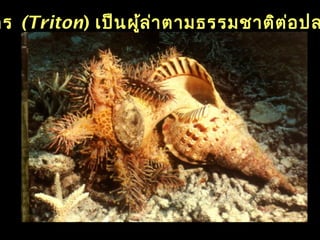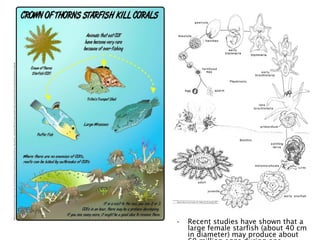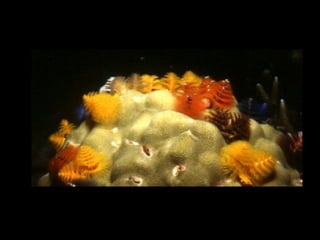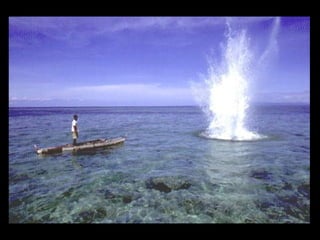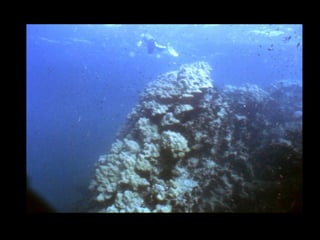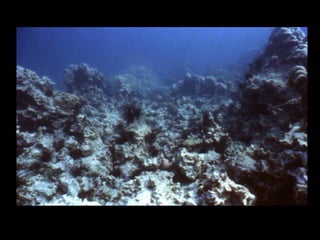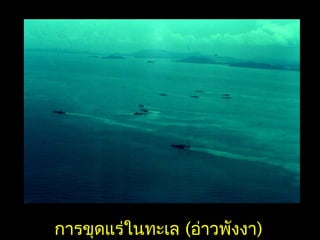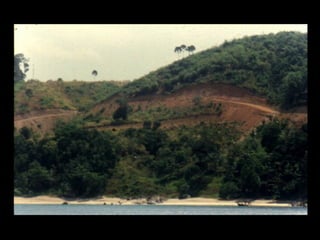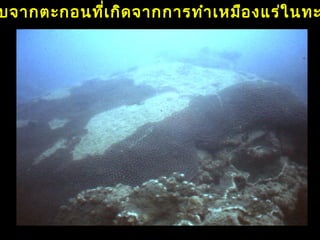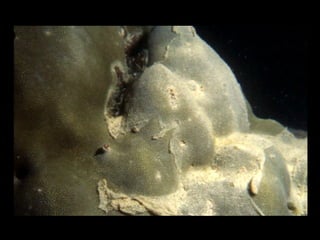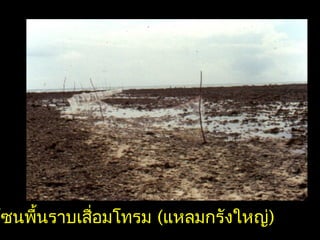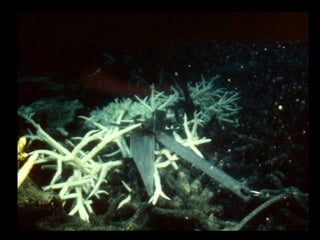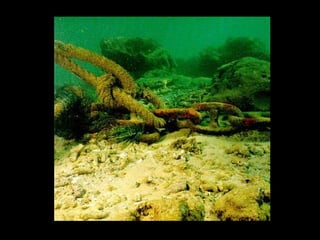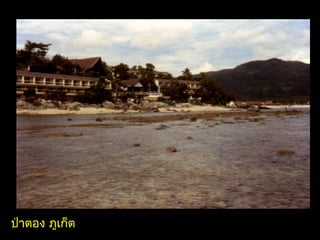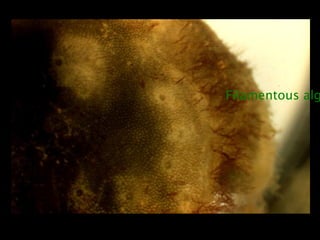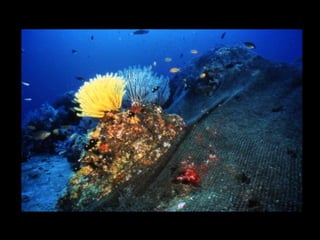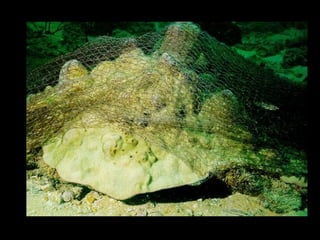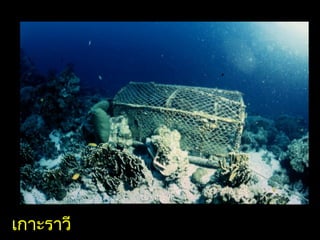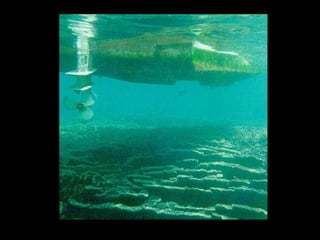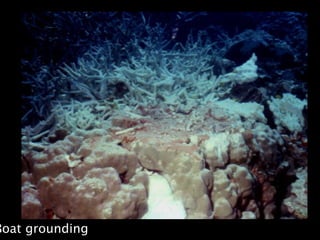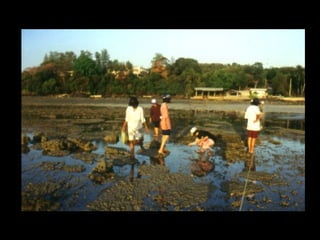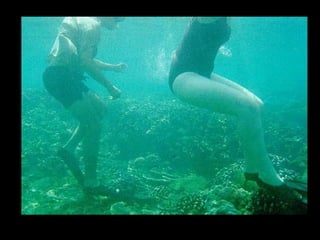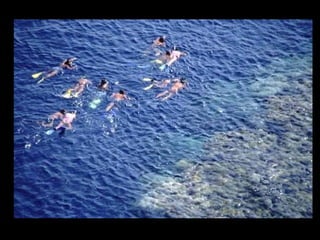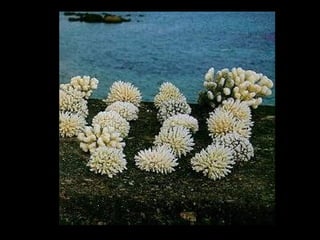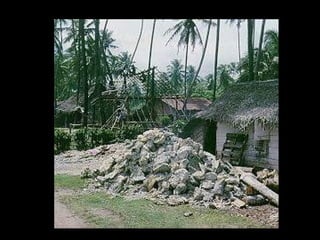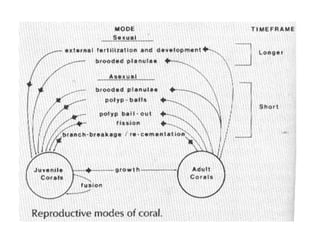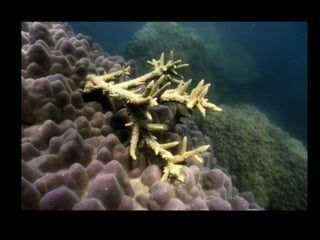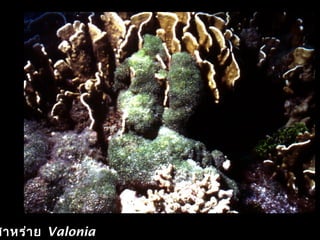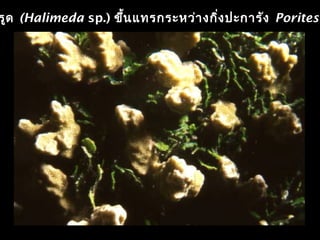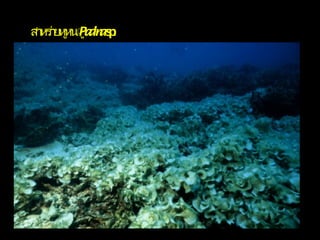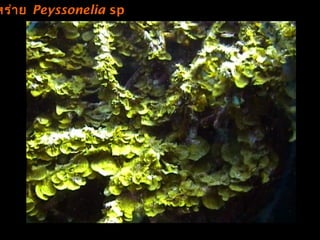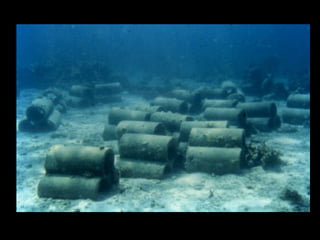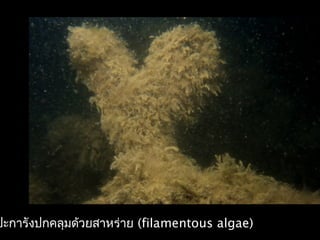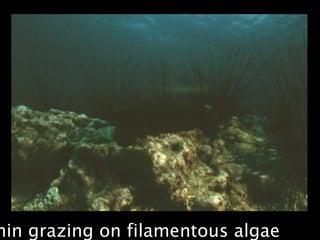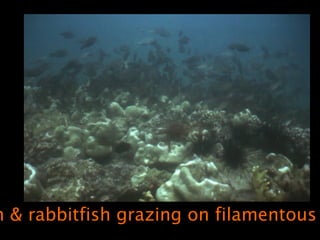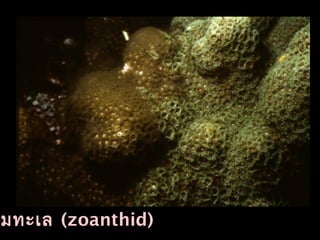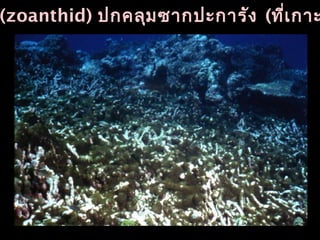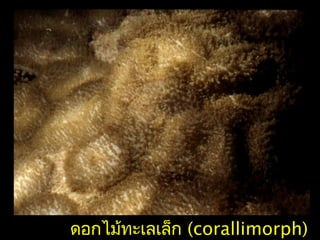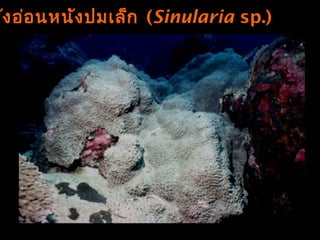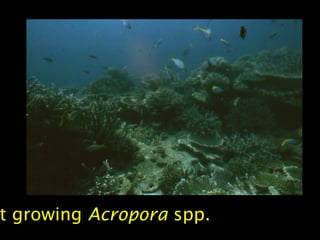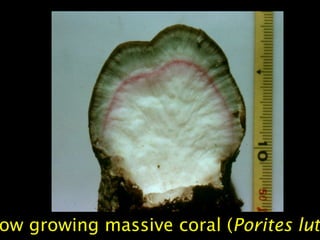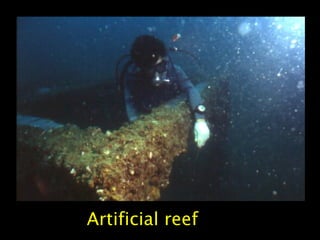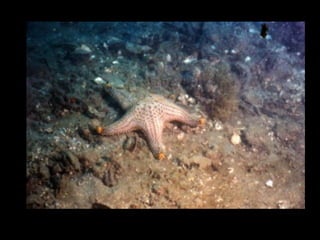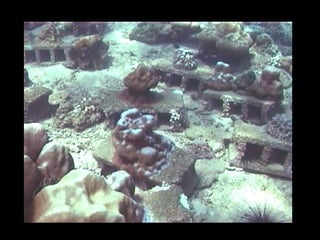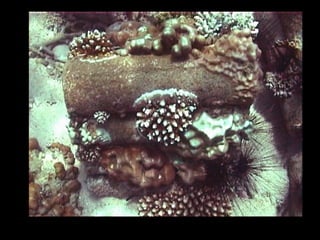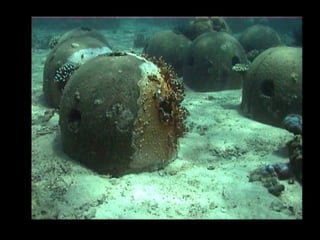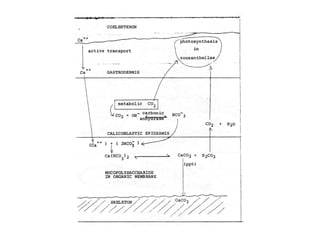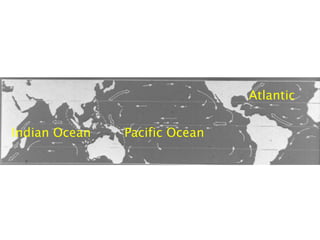Coral lec02
- 2. ÓĖøÓĖ▒ÓĖłÓĖłÓĖ▒ÓĖóÓĖŚÓĖĄÓ╣łÓĖĪÓĖĄÓĖ£ÓĖźÓĖĢÓ╣łÓĖŁÓĖüÓĖ▓ÓĖŻÓ╣üÓĖ×ÓĖŻÓ╣łÓĖüÓĖŻÓĖ░ÓĖłÓĖ▓ÓĖó ÓĖøÓĖ░ÓĖüÓĖ▓ÓĖŻÓĖ▒ÓĖć 1)Depth ŌĆō ÓĖ¬Ó╣łÓĖ¦ÓĖÖÓĖĪÓĖ▓ÓĖüÓĖøÓĖ░ÓĖüÓĖ▓ÓĖŻÓĖ▒ÓĖćÓĖ¬ÓĖŻÓ╣ēÓĖ▓ÓĖćÓ╣üÓĖÖÓĖ¦ ÓĖøÓĖ░ÓĖüÓĖ▓ÓĖŻÓĖ▒ÓĖćÓ╣äÓĖøÓĖłÓĖÖÓĖ¢ÓĖČÓĖćÓĖŻÓĖ░ÓĖöÓĖ▒ÓĖÜÓĖäÓĖ¦ÓĖ▓ÓĖĪÓĖźÓĖČÓĖüÓĖĪÓĖ▓ÓĖüÓĖŚÓĖĄÓ╣łÓĖ¬ÓĖĖÓĖö 30 - 40 Ó╣ĆÓĖĪÓĖĢÓĖŻ Ó╣üÓĖĢÓ╣łÓĖĪÓĖĄÓĖÜÓĖ▓ÓĖćÓĖŖÓĖÖÓĖ┤ÓĖöÓĖŁÓĖóÓĖ╣Ó╣łÓ╣äÓĖöÓ╣ēÓĖźÓĖČÓĖüÓĖ¢ÓĖČÓĖć 6000 Ó╣ĆÓĖĪÓĖĢÓĖŻ
- 3. 2) Temperature ŌĆō ÓĖøÓĖ░ÓĖüÓĖ▓ÓĖŻÓĖ▒ÓĖćÓ╣ĆÓĖłÓĖŻÓĖ┤ÓĖŹÓ╣ĆÓĖĢÓĖ┤ÓĖÜÓ╣éÓĖĢÓ╣äÓĖöÓ╣ē ÓĖöÓĖĄÓĖŚÓĖĄÓ╣łÓĖŁÓĖĖÓĖōÓĖ½ÓĖĀÓĖ╣ÓĖĪÓĖ┤ÓĖŁÓĖóÓĖ╣Ó╣łÓ╣āÓĖÖÓĖŖÓ╣łÓĖ¦ÓĖć 25┬░ C - 29┬░ C. ÓĖüÓĖźÓĖĖÓ╣łÓĖĪÓĖŚÓĖĄÓ╣łÓ╣ĆÓĖøÓ╣ćÓĖÖ Ahermatypic corals ÓĖ¬ÓĖ▓ÓĖĪÓĖ▓ÓĖŻÓĖ¢ÓĖŁÓĖóÓĖ╣Ó╣ł Ó╣äÓĖöÓ╣ēÓĖŚÓĖĄÓ╣łÓĖŁÓĖĖÓĖōÓĖ½ÓĖĀÓĖ╣ÓĖĪÓĖ┤ 1┬░ C - 4┬░ C
- 4. 3) Salinity ŌĆō Hermatypic corals ÓĖŚÓĖÖÓĖäÓĖ¦ÓĖ▓ÓĖĪ Ó╣ĆÓĖäÓ╣ćÓĖĪÓĖéÓĖŁÓĖćÓĖÖÓĖ│Ó╣ēÓĖ▓ÓĖŚÓĖ░Ó╣ĆÓĖźÓĖŁÓĖóÓĖ╣Ó╣łÓ╣āÓĖÖÓĖŖÓ╣łÓĖ¦ÓĖć 27 - 40 parts- per-thousand
- 5. 4) Light ŌĆō ÓĖøÓĖ░ÓĖüÓĖ▓ÓĖŻÓĖ▒ÓĖćÓĖŚÓĖĖÓĖüÓĖŖÓĖÖÓĖ┤ÓĖöÓĖŚÓĖĄÓ╣łÓĖĪÓĖĄÓĖ¬ÓĖ▓ÓĖ½ÓĖŻÓ╣łÓĖ▓ÓĖóÓ╣ĆÓĖŗÓĖźÓĖźÓ╣ī Ó╣ĆÓĖöÓĖĄÓĖóÓĖ¦Ó╣āÓĖÖÓ╣ĆÓĖÖÓĖĘÓ╣ēÓĖŁÓ╣ĆÓĖóÓĖĘÓ╣łÓĖŁÓĖĢÓ╣ēÓĖŁÓĖćÓĖüÓĖ▓ÓĖŻÓ╣üÓĖ¬ÓĖćÓ╣ĆÓĖøÓ╣ćÓĖÖÓĖøÓĖ▒ÓĖłÓĖłÓĖ▒ÓĖóÓĖ¬ÓĖ│ÓĖ▓ÓĖäÓĖ▒ÓĖŹ Ó╣āÓĖÖÓĖüÓĖ▓ÓĖŻÓĖöÓĖ│ÓĖ▓ÓĖŻÓĖćÓĖŖÓĖĄÓĖ¦ÓĖ┤ÓĖĢ ÓĖóÓĖüÓ╣ĆÓĖ¦Ó╣ēÓĖÖÓĖÜÓĖ▓ÓĖćÓĖüÓĖźÓĖĖÓ╣łÓĖĪÓĖŚÓĖĄÓ╣łÓ╣äÓĖĪÓ╣łÓĖĪÓĖĄ ÓĖ¬ÓĖ▓ÓĖ½ÓĖŻÓ╣łÓĖ▓ÓĖóÓ╣ĆÓĖŗÓĖźÓĖźÓ╣īÓ╣ĆÓĖöÓĖĄÓĖóÓĖ¦Ó╣āÓĖÖÓ╣ĆÓĖÖÓĖĘÓ╣ēÓĖŁÓ╣ĆÓĖóÓĖĘÓ╣łÓĖŁÓĖŚÓĖĄÓ╣łÓĖ¬ÓĖ▓ÓĖĪÓĖ▓ÓĖŻÓĖ¢Ó╣üÓĖ×ÓĖŻÓ╣ł ÓĖüÓĖŻÓĖ░ÓĖłÓĖ▓ÓĖóÓ╣äÓĖöÓ╣ēÓ╣āÓĖÖÓĖŚÓĖĄÓ╣łÓĖźÓĖČÓĖü
- 7. 5. Run-off and sedimentation Ó╣ĆÓĖøÓ╣ćÓĖÖÓĖøÓĖ▒ÓĖłÓĖłÓĖ▒ÓĖóÓĖŚÓĖĄÓ╣łÓ╣ĆÓĖüÓĖĄÓ╣łÓĖóÓĖ¦ÓĖéÓ╣ēÓĖŁÓĖćÓĖüÓĖ▒ÓĖÜÓĖüÓĖ▓ÓĖŻÓ╣üÓĖ×ÓĖŻÓ╣łÓĖüÓĖŻÓĖ░ÓĖłÓĖ▓ÓĖó ÓĖĪÓĖ▒ÓĖüÓĖłÓĖ░Ó╣äÓĖĪÓ╣łÓĖ×ÓĖÜÓ╣üÓĖÖÓĖ¦ÓĖøÓĖ░ÓĖüÓĖ▓ÓĖŻÓĖ▒ÓĖćÓĖÜÓĖŻÓĖ┤Ó╣ĆÓĖ¦ÓĖōÓĖøÓĖ▓ÓĖüÓ╣üÓĖĪÓ╣łÓĖÖÓĖ│Ó╣ēÓĖ▓ÓĖ½ÓĖŻÓĖĘÓĖŁÓ╣āÓĖÖÓĖÜÓĖŻÓĖ┤Ó╣ĆÓĖ¦ÓĖōÓĖŖÓĖ▓ÓĖóÓĖØÓĖ▒Ó╣łÓĖćÓĖŚÓĖĄÓ╣łÓĖĪÓĖĄ ÓĖøÓĖŻÓĖ┤ÓĖĪÓĖ▓ÓĖōÓĖĢÓĖ░ÓĖüÓĖŁÓĖÖÓ╣äÓĖ½ÓĖźÓĖźÓĖćÓĖłÓĖ▓ÓĖüÓ╣üÓĖ£Ó╣łÓĖÖÓĖöÓĖ┤ÓĖÖ ÓĖĢÓĖ░ÓĖüÓĖŁÓĖÖÓĖ¬Ó╣łÓĖćÓĖ£ÓĖźÓĖĢÓ╣łÓĖŁÓĖüÓĖ▓ÓĖŻÓ╣ĆÓĖłÓĖŻÓĖ┤ÓĖŹÓ╣ĆÓĖĢÓĖ┤ÓĖÜÓ╣éÓĖĢÓ╣üÓĖźÓĖ░ÓĖŁÓĖćÓĖäÓ╣īÓĖøÓĖŻÓĖ░ÓĖüÓĖŁÓĖćÓĖŚÓĖ▓ÓĖćÓĖ¬ÓĖ▒ÓĖćÓĖäÓĖĪÓĖéÓĖŁÓĖćÓĖøÓĖ░ÓĖüÓĖ▓ÓĖŻÓĖ▒ÓĖć ÓĖĢÓĖ░ÓĖüÓĖŁÓĖÖÓĖ¬ÓĖ▓ÓĖĪÓĖ▓ÓĖŻÓĖ¢ÓĖ¬Ó╣łÓĖćÓĖ£ÓĖźÓ╣āÓĖ½Ó╣ēÓĖøÓĖ░ÓĖüÓĖ▓ÓĖŻÓĖ▒ÓĖćÓĖĢÓĖ▓ÓĖóÓ╣äÓĖöÓ╣ēÓ╣āÓĖÖÓĖŻÓĖ░ÓĖóÓĖ░Ó╣ĆÓĖ¦ÓĖźÓĖ▓ÓĖŚÓĖĄÓ╣łÓĖ¬ÓĖ▒Ó╣ēÓĖÖ ÓĖÖÓĖŁÓĖüÓĖłÓĖ▓ÓĖüÓĖÖÓĖ▒Ó╣ēÓĖÖ ÓĖ½ÓĖ▓ÓĖüÓĖĢÓĖ░ÓĖüÓĖŁÓĖÖÓĖĪÓĖĄÓĖøÓĖŻÓĖ┤ÓĖĪÓĖ▓ÓĖōÓĖĪÓĖ▓ÓĖüÓĖŁÓĖ▓ÓĖłÓĖłÓĖ░ÓĖŚÓĖ│ÓĖ▓Ó╣āÓĖ½Ó╣ēÓĖźÓĖöÓĖŁÓĖ▒ÓĖĢÓĖŻÓĖ▓ÓĖüÓĖ▓ÓĖŻÓĖŚÓĖöÓ╣üÓĖŚÓĖÖÓĖŚÓĖĄÓ╣łÓĖéÓĖŁÓĖć ÓĖøÓĖŻÓĖ░ÓĖŖÓĖ▓ÓĖüÓĖŻÓ╣äÓĖöÓ╣ē ÓĖŻÓĖ¦ÓĖĪÓĖ¢ÓĖČÓĖćÓĖäÓĖ¦ÓĖ▓ÓĖĪÓĖ½ÓĖźÓĖ▓ÓĖüÓĖ½ÓĖźÓĖ▓ÓĖó ÓĖüÓĖ▓ÓĖŻÓ╣ĆÓĖĢÓĖ┤ÓĖÜÓ╣éÓĖĢÓ╣üÓĖźÓĖ░ÓĖøÓĖüÓĖäÓĖĖÓĖźÓĖĪÓĖ×ÓĖĘÓ╣ēÓĖÖÓĖŚÓĖĄÓ╣łÓĖłÓĖÖÓĖÖÓĖ│ÓĖ▓ Ó╣äÓĖøÓĖ¬ÓĖ╣Ó╣łÓĖüÓĖ▓ÓĖŻÓ╣ĆÓĖøÓĖźÓĖĄÓ╣łÓĖóÓĖÖÓ╣üÓĖøÓĖźÓĖćÓĖŻÓĖ╣ÓĖøÓĖŚÓĖŻÓĖćÓĖéÓĖŁÓĖćÓĖøÓĖ░ÓĖüÓĖ▓ÓĖŻÓĖ▒ÓĖć ÓĖŁÓĖóÓ╣łÓĖ▓ÓĖćÓ╣äÓĖŻÓĖüÓ╣ćÓĖĢÓĖ▓ÓĖĪÓĖøÓĖ░ÓĖüÓĖ▓ÓĖŻÓĖ▒ÓĖćÓĖĪÓĖĄÓĖüÓĖźÓ╣äÓĖøÓ╣āÓĖÖÓĖüÓĖ▓ÓĖŻÓĖüÓĖ│ÓĖ▓ÓĖłÓĖ▒ÓĖöÓĖĢÓĖ░ÓĖüÓĖŁÓĖÖÓĖŁÓĖŁÓĖüÓĖłÓĖ▓ÓĖüÓ╣éÓĖäÓ╣éÓĖźÓĖÖÓĖĄÓ╣äÓĖöÓ╣ē Ó╣éÓĖöÓĖóÓĖ¦ÓĖ┤ÓĖśÓĖĄ active and passive sediment rejection ÓĖüÓĖźÓĖóÓĖĖÓĖŚÓĖśÓ╣īÓĖŚÓĖĄÓ╣łÓ╣āÓĖŖÓ╣ēÓ╣āÓĖÖÓĖéÓĖÜÓĖ¦ÓĖÖÓĖüÓĖ▓ÓĖŻ active Ó╣äÓĖöÓ╣ēÓ╣üÓĖüÓ╣ł polyp expansion tentacular and cilliary movement sediment ingestion and mucus formation ÓĖŁÓĖóÓ╣łÓĖ▓ÓĖćÓ╣äÓĖŻÓĖüÓ╣ćÓĖĢÓĖ▓ÓĖĪÓĖéÓĖÜÓĖ¦ÓĖÖÓĖüÓĖ▓ÓĖŻ Ó╣ĆÓĖ½ÓĖźÓ╣łÓĖ▓ÓĖÖÓĖĄÓ╣ēÓ╣ĆÓĖøÓ╣ćÓĖÖÓĖüÓĖ▓ÓĖŻÓĖ¬ÓĖ╣ÓĖŹÓ╣ĆÓĖ¬ÓĖĄÓĖóÓĖ×ÓĖźÓĖ▒ÓĖćÓĖćÓĖ▓ÓĖÖÓĖäÓ╣łÓĖŁÓĖÖÓĖéÓ╣ēÓĖ▓ÓĖć ÓĖŗÓĖČÓ╣łÓĖćÓĖ½ÓĖ▓ÓĖüÓĖĪÓĖĄÓĖüÓĖ▓ÓĖŻÓ╣āÓĖŖÓ╣ēÓĖŁÓĖóÓ╣łÓĖ▓ÓĖćÓĖĢÓ╣łÓĖŁÓ╣ĆÓĖÖÓĖĘÓ╣łÓĖŁÓĖć ÓĖŖÓ╣łÓĖ¦ÓĖćÓĖŻÓĖ░ÓĖóÓĖ░Ó╣ĆÓĖ¦ÓĖźÓĖ▓ÓĖ½ÓĖÖÓĖČÓ╣łÓĖćÓĖŁÓĖ▓ÓĖłÓĖ¬Ó╣łÓĖćÓĖ£ÓĖźÓ╣āÓĖ½Ó╣ēÓĖøÓĖ░ÓĖüÓĖ▓ÓĖŻÓĖ▒ÓĖćÓĖŁÓ╣łÓĖŁÓĖÖÓ╣üÓĖŁ Ó╣üÓĖźÓĖ░ÓĖĢÓĖ▓ÓĖóÓ╣āÓĖÖÓĖŚÓĖĄÓ╣łÓĖ¬ÓĖĖÓĖö
- 10. Ó╣üÓĖÖÓĖ¦ÓĖøÓĖ░ÓĖüÓĖ▓ÓĖŻÓĖ▒ÓĖć (Coral Reef) Ó╣éÓĖäÓĖŻÓĖćÓĖ¬ÓĖŻÓ╣ēÓĖ▓ÓĖćÓĖ½ÓĖ┤ÓĖÖÓĖøÓĖ╣ÓĖÖÓĖŚÓĖĄÓ╣łÓĖüÓ╣łÓĖŁÓĖĢÓĖ▒ÓĖ¦Ó╣ĆÓĖøÓ╣ćÓĖÖÓ╣üÓĖÖÓĖ¦Ó╣āÓĖĢÓ╣ēÓĖŚÓĖ░Ó╣ĆÓĖź Ó╣āÓĖÖÓĖŻÓĖ░ÓĖöÓĖ▒ÓĖÜÓĖŚÓĖĄÓ╣ł Ó╣üÓĖ¬ÓĖćÓ╣üÓĖöÓĖöÓĖ¬Ó╣łÓĖŁÓĖćÓĖ¢ÓĖČÓĖć Ó╣éÓĖäÓĖŻÓĖćÓĖ¬ÓĖŻÓ╣ēÓĖ▓ÓĖćÓĖÖÓĖĄÓ╣ēÓ╣ĆÓĖüÓĖ┤ÓĖöÓĖłÓĖ▓ÓĖü Calcareous skeleton ÓĖéÓĖŁÓĖćÓĖ¬ÓĖ┤Ó╣łÓĖćÓĖĪÓĖĄÓĖŖÓĖĄÓĖ¦ÓĖ┤ÓĖĢÓĖ½ÓĖźÓĖ▓ÓĖóÓĖŖÓĖÖÓĖ┤ÓĖö Ó╣üÓĖĢÓ╣łÓĖĢÓĖ▒ÓĖ¦ÓĖŚÓĖĄÓ╣łÓ╣ĆÓĖöÓ╣łÓĖÖÓĖŚÓĖĄÓ╣łÓĖ¬ÓĖĖÓĖö
- 11. Turn on and turn off !!!!!!!!
- 12. Limiting factors in the coral reef Nutrition or Space?
- 13. ŌĆó ÓĖüÓĖźÓ╣äÓĖüÓ╣āÓĖÖÓĖüÓĖ▓ÓĖŻÓ╣üÓĖüÓ╣łÓĖćÓ╣üÓĖóÓ╣łÓĖćÓĖ×ÓĖĘÓ╣ēÓĖÖÓĖŚÓĖĄÓ╣ł 1.Creating longer fighting polyps Ó╣éÓĖöÓĖóÓ╣āÓĖŖÓ╣ē sweeper tentacle ÓĖŗÓĖČÓ╣łÓĖćÓĖøÓĖŻÓĖ░ÓĖüÓĖŁÓĖÜÓĖöÓ╣ēÓĖ¦ÓĖó nematocyst ÓĖłÓĖ│ÓĖ▓ÓĖÖÓĖ¦ÓĖÖÓĖĪÓĖ▓ÓĖü ÓĖ¬ÓĖ▓ÓĖĪÓĖ▓ÓĖŻÓĖ¢ÓĖóÓĖĘÓ╣łÓĖÖÓĖóÓĖ▓ÓĖ¦ÓĖŁÓĖŁÓĖüÓĖĪÓĖ▓Ó╣äÓĖöÓ╣ēÓĖ¢ÓĖČÓĖć 5 Ó╣ĆÓĖŚÓ╣łÓĖ▓ 2.Throwing mesenterial filament, ÓĖóÓĖĘÓ╣łÓĖÖÓĖóÓĖ▓ÓĖ¦ÓĖŁÓĖŁÓĖüÓĖĪÓĖ▓ ÓĖĀÓĖ▓ÓĖóÓĖÖÓĖŁÓĖüÓ╣éÓĖ×ÓĖźÓĖ┤ÓĖø 3.Producing mucus with nematocysts. ÓĖ×ÓĖÜÓ╣āÓĖÖ ÓĖøÓĖ░ÓĖüÓĖ▓ÓĖŻÓĖ▒ÓĖćÓĖöÓĖŁÓĖüÓ╣ĆÓĖ½Ó╣ćÓĖö (Fungia) Ó╣ĆÓĖĪÓĖĘÓĖŁÓĖüÓĖłÓĖ░ÓĖ¢ÓĖ╣ÓĖüÓĖ£ÓĖźÓĖ┤ÓĖĢÓĖŁÓĖŁÓĖüÓĖĪÓĖ▓ ÓĖŖÓ╣łÓĖ¦ÓĖćÓ╣ĆÓĖ¦ÓĖźÓĖ▓ÓĖüÓĖźÓĖ▓ÓĖćÓĖäÓĖĘÓĖÖ
- 15. Sweeper tentacle
- 16. Ó╣üÓĖóÓ╣łÓĖćÓĖ×ÓĖĘÓ╣ēÓĖÖÓĖŚÓĖĄÓ╣ł (competition for space) Sinularia Diploastrea Acropora Platygyra Acropora Dead zone
- 20. ÓĖÖ Amphiroa sp.? ÓĖéÓĖČÓ╣ēÓĖÖÓ╣üÓĖŚÓĖŻÓĖüÓĖŻÓĖ░ÓĖ½ÓĖ¦Ó╣łÓĖ▓ÓĖćÓĖüÓĖ┤Ó╣łÓĖćÓĖøÓĖ░ÓĖüÓĖ▓ÓĖŻÓĖ▒ÓĖć Por
- 22. ÓĖ½ÓĖŁÓĖóÓĖĪÓĖĘÓĖŁÓ╣ĆÓĖ¬ÓĖĘÓĖŁ giant clam (Tridacna squamosa)
- 24. ÓĖüÓĖ▓ÓĖŻÓĖ¬ÓĖźÓĖ▓ÓĖó (Destruction)ŌĆóÓĖŚÓĖ▓ÓĖćÓĖŖÓĖĄÓĖ¦ÓĖĀÓĖ▓ÓĖ× - Bioerosion ŌĆōBorer: macroborer, microborer ŌĆōGrazer
- 27. Mechanism of reef-front progradation by splitting and regrowth of massive colonies Eroded by boring organisms e.g. Upogebia shrimp, Pendum spondyloideum bivalves
- 28. n block of massive Porites lutea
- 35. ÓĖ¬ÓĖ┤Ó╣łÓĖćÓĖĪÓĖĄÓĖŖÓĖĄÓĖ¦ÓĖ┤ÓĖĢÓ╣āÓĖÖÓ╣üÓĖÖÓĖ¦ ÓĖøÓĖ░ÓĖüÓĖ▓ÓĖŻÓĖ▒ÓĖć ŌĆó ÓĖüÓĖźÓĖĖÓ╣łÓĖĪÓĖ¬ÓĖ▒ÓĖĢÓĖ¦Ó╣ī ÓĖ×ÓĖĘÓĖŖ ÓĖŚÓĖĄÓ╣łÓ╣ĆÓĖøÓ╣ćÓĖÖÓĖĢÓĖ▒ÓĖ¦ÓĖ½ÓĖźÓĖ▒ÓĖü (Essential fauna & flora) ŌĆó ÓĖüÓĖźÓĖĖÓ╣łÓĖĪÓĖ¬ÓĖ▒ÓĖĢÓĖ¦Ó╣ī ÓĖ×ÓĖĘÓĖŖ ÓĖŚÓĖĄÓ╣łÓ╣ĆÓĖéÓ╣ēÓĖ▓ÓĖĪÓĖ▓Ó╣ĆÓĖüÓĖĄÓ╣łÓĖóÓĖ¦ÓĖéÓ╣ēÓĖŁÓĖć (Associated fauna & flora) ŌĆóEpifuana & epiflora ŌĆóMobile fauna
- 36. ellid - (tube polychaete worm)
- 37. a anemone & clown fish
- 43. ÓĖöÓĖ▓ÓĖ¦ÓĖĪÓĖćÓĖüÓĖĖÓĖÄÓĖ½ÓĖÖÓĖ▓ÓĖĪ (Crown of thorns starfish)
- 48. ÓĖÖÓĖ│Ó╣ēÓĖ▓ Sponge (Xestospongia sp.) Biofilter - Ó╣ĆÓĖäÓĖŻÓĖĘÓ╣łÓĖŁÓĖćÓĖüÓĖŻÓĖŁÓĖćÓĖÖÓĖ│Ó╣ēÓĖ▓
- 51. ÓĖöÓĖ▓ÓĖ¦ÓĖéÓĖÖÓĖÖÓĖü (Feather sea star)
- 56. ÓĖŁÓ╣ĆÓĖ¬ÓĖĘÓĖŁ Giant clam (Tridacna sp.)
- 57. ÓĖŁÓĖ½ÓĖĪÓĖĄ Rock oyster (Hyotissa hyotis )
- 58. Ó╣ĆÓĖź Sea cucumber (Obhadschia graef
- 73. Ó╣ĆÓĖ¬ÓĖĘÓĖŁÓĖöÓĖ▓ÓĖ¦ Leopard shark (Stegostoma fasciatum
- 77. ÓĖŁÓĖ▒ÓĖĢÓĖŻÓĖ▓ÓĖüÓĖ▓ÓĖŻÓĖ£ÓĖźÓĖ┤ÓĖĢÓ╣ĆÓĖÜÓĖĘÓ╣ēÓĖŁÓĖćÓĖĢÓ╣ēÓĖÖÓĖ¬ÓĖĖÓĖŚÓĖśÓĖ┤Ó╣üÓĖźÓĖ░ÓĖĪÓĖ¦ÓĖźÓĖŖÓĖĄÓĖ¦ÓĖĀÓĖ▓ÓĖ×ÓĖéÓĖŁÓĖć ÓĖŻÓĖ░ÓĖÜÓĖÜÓĖÖÓĖ┤Ó╣ĆÓĖ¦ÓĖ© (Whittaker and Liken, 1973) ÓĖŻÓĖ░ÓĖÜÓĖÜÓĖÖÓĖ┤Ó╣ĆÓĖ¦ÓĖ© ÓĖ×ÓĖĘÓ╣ēÓĖÖÓĖŚÓĖĄÓ╣ł (x106 km2 ) ÓĖäÓ╣łÓĖ▓Ó╣ĆÓĖēÓĖźÓĖĄÓ╣łÓĖóÓĖŁÓĖ▒ÓĖĢÓĖŻÓĖ▓ ÓĖäÓ╣łÓĖ▓Ó╣ĆÓĖēÓĖźÓĖĄÓ╣łÓĖóÓĖĪÓĖ¦ÓĖźÓĖŖÓĖĄÓĖ¦ÓĖĀÓĖ▓ÓĖ× ÓĖüÓĖ▓ÓĖŻÓĖ£ÓĖźÓĖ┤ÓĖĢÓ╣ĆÓĖÜÓĖĘÓ╣ēÓĖŁÓĖćÓĖĢÓ╣ēÓĖÖ (ÓĖüÓĖü./ÓĖøÓĖĄ) ÓĖ¬ÓĖĖÓĖŚÓĖśÓĖ┤ (ÓĖüÓĖŻÓĖ▒ÓĖĪ/ÓĖĪ2 /ÓĖøÓĖĄ) ÓĖøÓ╣łÓĖ▓ÓĖöÓĖ┤ÓĖÜÓĖØÓĖÖÓ╣ĆÓĖéÓĖĢÓĖŻÓ╣ēÓĖŁÓĖÖ 17 2200 45 ÓĖ×ÓĖĘÓ╣ēÓĖÖÓĖŚÓĖĄÓ╣łÓ╣ĆÓĖ×ÓĖ▓ÓĖ░ÓĖøÓĖźÓĖ╣ÓĖü 14 650 14 ÓĖŚÓĖ░Ó╣ĆÓĖźÓ╣ĆÓĖøÓĖ┤ÓĖö 332 125 0.003 Ó╣üÓĖÖÓĖ¦ÓĖøÓĖ░ÓĖüÓĖ▓ÓĖŻÓĖ▒ÓĖć 0.6 2500
- 78. Grazing food chain ŌĆō parrot fish, sea urchin, gastopod etc.
- 79. ÓĖĢ (ÓĖüÓĖü./ÓĖĢÓĖŻ.ÓĖüÓĖĪ./ÓĖøÓĖĄ)ÓĖĀÓĖ▓ÓĖóÓ╣āÓĖÖ trophic level ÓĖĢÓ╣łÓĖ▓ÓĖćÓ╣å ÓĖŚÓĖĄÓ╣ł French Frig
- 83. Ó╣ĆÓĖøÓĖŻÓĖĄÓĖóÓĖÜÓ╣ĆÓĖŚÓĖĄÓĖóÓĖÜÓĖäÓĖ¦ÓĖ▓ÓĖĪÓ╣üÓĖĢÓĖüÓĖĢÓ╣łÓĖ▓ÓĖć ÓĖéÓĖŁÓĖćÓ╣üÓĖÖÓĖ¦ÓĖøÓĖ░ÓĖüÓĖ▓ÓĖŻÓĖ▒ÓĖć ŌĆó Indo-Pacific ŌĆō fringing reef, Barrier reef, At oll ŌĆō algal ridge ŌĆō coral ~ 70 genera, ~ 400 s pp. ŌĆō Heliopora (blue coral) ŌĆó Tropical Atlantic ŌĆō only fringing reef ŌĆō no algal ridge (or very scarce ) ŌĆō coral ~ 26 genera, ~ 35 s pp.
- 85. opora palmata in Caribbean
- 86. ÓĖüÓĖ▓ÓĖŻÓ╣üÓĖ×ÓĖŻÓ╣łÓĖüÓĖŻÓĖ░ÓĖłÓĖ▓ÓĖóÓŠ║ÓĖŁÓĖćÓĖøÓĖ░ÓĖüÓĖ▓ÓĖŻÓĖ▒ÓĖćÓ╣āÓĖÖÓĖÖÓ╣łÓĖ▓ÓĖÖÓĖÖ - ÓĖźÓĖĪÓĖĪÓĖŻÓĖĖÓĖ¬ÓĖĪÓĖĢÓĖ░ÓĖ¦ÓĖ▒ÓĖÖÓĖĢÓĖüÓ╣ĆÓĖēÓĖĄÓĖóÓĖćÓ╣āÓĖĢÓ╣ē - ÓĖźÓĖĪÓĖĪÓĖŻÓĖ¬ÓĖĖÓĖĪÓĖĢÓĖ░ÓĖ¦ÓĖ▒ÓĖÖÓĖŁÓĖŁÓĖüÓ╣ĆÓĖēÓĖĄÓĖóÓĖćÓ╣ĆÓĖ½ÓĖÖÓĖĘÓĖŁ - ÓĖØÓĖ▒Ó╣łÓĖćÓĖŚÓĖ░Ó╣ĆÓĖźÓĖŁÓĖ▒ÓĖÖÓĖöÓĖ▓ÓĖĪÓĖ▒ÓĖÖ - ÓĖØÓĖ▒Ó╣łÓĖćÓĖŁÓ╣łÓĖ▓ÓĖ¦Ó╣äÓĖŚÓĖóÓĖØÓĖ▒Ó╣łÓĖćÓĖĢÓĖ░ÓĖ¦ÓĖ▒ÓĖÖÓĖŁÓĖŁÓĖü - ÓĖØÓĖ▒Ó╣łÓĖćÓĖŁÓ╣łÓĖ▓ÓĖ¦Ó╣äÓĖŚÓĖóÓĖØÓĖ▒Ó╣łÓĖćÓĖĢÓĖ░ÓĖ¦ÓĖ▒ÓĖÖÓĖĢÓĖü
- 87. West coast - Phuket
- 91. encrusting fire coral encrusting staghorn coral
- 92. Cauliflower coral (Pocillopora meand
- 93. ral encrusting on rock surface
- 94. ÓĖéÓĖ▓ÓĖüÓĖ¦ÓĖ▓ÓĖć Staghorn coal (Acropora robusta)
- 95. ommunity on rocky coast (windward site)
- 96. ÓĖøÓĖŻÓĖ░Ó╣ĆÓĖĀÓĖŚÓĖéÓĖŁÓĖćÓ╣üÓĖÖÓĖ¦ÓĖøÓĖ░ÓĖüÓĖ▓ÓĖŻÓĖ▒ÓĖć ŌĆóFringing reef ŌĆóBarrier reef ŌĆóAtoll
- 98. Fringing reef Barrier reef Atoll ÓĖüÓĖ▓ÓĖŻÓĖ×ÓĖ▒ÓĖÆÓĖÖÓĖ▓ÓĖüÓĖ▓ÓĖŻÓĖüÓ╣łÓĖŁÓĖĢÓĖ▒ÓĖ¦ÓĖéÓĖŁÓĖćÓ╣üÓĖÖÓĖ¦ÓĖøÓĖ░ÓĖüÓĖ▓ÓĖŻÓĖ▒ÓĖć Ó╣üÓĖÜÓĖÜÓĖĢÓ╣łÓĖ▓ÓĖćÓ╣å (DarwinŌĆÖs theory)
- 100. Fringing reef
- 101. Fringing reef
- 102. arrier reef lagoon
- 105. Typical Reef Zonation ŌĆóReef flat - ÓĖ×ÓĖĘÓ╣ēÓĖÖ ÓĖŻÓĖ▓ÓĖÜÓ╣üÓĖÖÓĖ¦ÓĖøÓĖ░ÓĖüÓĖ▓ÓĖŻÓĖ▒ÓĖć ŌĆóReef edge - Ó╣äÓĖ½ÓĖźÓ╣ł Ó╣üÓĖÖÓĖ¦ÓĖøÓĖ░ÓĖüÓĖ▓ÓĖŻÓĖ▒ÓĖć ŌĆóReef slope - ÓĖźÓĖ▓ÓĖö
- 108. Reef flat
- 110. Tidal pool on reef fla
- 111. Padina
- 112. microatoll
- 113. ora sp. (digitate form) on reef flat
- 116. Reef flat - ÓĖ¬ÓĖ┤ÓĖĪÓĖ┤ÓĖźÓĖ▒ÓĖÖ
- 117. ont part of reef flat
- 118. ont part of reef flat
- 120. eef edge zone
- 121. groove system (surge ch
- 122. surge channel
- 123. Algal ridge
- 125. Reef edge
- 127. Reef edge - Ó╣Č─ÓĖüÓĖ▓ÓĖ░ÓĖÜÓĖ╣ÓĖĢÓĖŁÓĖć
- 128. Lithophyllon sp.
- 129. ÓĖÖÓĖ┤Ó╣ēÓĖ¦ (Porites nigrescens) ÓĖÜÓĖÖ reef slope
- 131. mid-slope zone Hydnophora rigida Ó╣ĆÓĖüÓĖ▓ÓĖ░ 8 - ÓĖ¬ÓĖ┤ÓĖĪÓĖ┤ÓĖźÓĖ▒ÓĖÖ
- 132. cropora grandis
- 134. ÓĖøÓĖźÓĖ▓ÓĖóÓ╣ĆÓĖéÓ╣ćÓĖĪ Needle coral (Seriatopora hystrix)
- 138. Ó╣éÓĖéÓĖö (Porites lutea) ÓĖÜÓĖŻÓĖ┤Ó╣ĆÓĖ¦ÓĖōÓĖ¬Ó╣łÓĖ¦ÓĖÖÓĖźÓ╣łÓĖ▓ÓĖćÓĖéÓĖŁÓĖć slope zone
- 139. s (Synaraea) rus on lower reef slope
- 140. Lower reef slope zone ÓĖøÓĖ░ÓĖüÓĖ▓ÓĖŻÓĖ▒ÓĖćÓĖŖÓ╣łÓĖŁÓĖćÓĖ½ÓĖÖÓĖ▓ÓĖĪ (Echinopora lamel
- 141. ÓĖøÓĖ░ÓĖüÓĖ▓ÓĖŻÓĖ▒ÓĖćÓĖłÓĖ▓ÓĖÖ Disc coral (Turbinaria reni
- 147. agram of atoll (Ó╣üÓĖ¬ÓĖČŽĖćÓĖČŽ╣ēÓĖ▓ÓĖÖÓ╣Č─ÓĖČŽĖĄÓĖóÓĖ¦)
- 149. Thick staghorn coral (Acropora palifera) Fire coral (Millepora sp ÓĖŻÓĖ┤Ó╣ĆÓĖ¦ÓĖōÓĖüÓĖŻÓĖ░Ó╣üÓĖ¬ÓĖÖÓĖ│Ó╣ēÓĖ▓Ó╣äÓĖ½ÓĖźÓ╣ĆÓĖŖÓĖĄÓ╣łÓĖóÓĖ¦
- 154. rvices of coral reef ecosystem (Moberg and Folke, 199 Biotic services Biotic services biogeo (whithin ecosystem) (between ecosystem) n Maintenance export organic Nit of habitat production to pelagic foodweb Maintenance of Ca2 biodiversity and genetic library
- 155. ÓĖøÓĖ▒ÓĖłÓĖłÓĖ▒ÓĖóÓĖŚÓĖĄÓ╣łÓĖĪÓĖĄÓĖ£ÓĖźÓĖŚÓĖ│ÓĖ▓Ó╣āÓĖ½Ó╣ēÓ╣üÓĖÖÓĖ¦ÓĖøÓĖ░ÓĖüÓĖ▓ÓĖŻÓĖ▒ÓĖćÓ╣ĆÓĖ¬ÓĖĘÓ╣łÓĖŁÓĖĪÓ╣éÓĖŚÓĖŻÓĖĪ ŌĆó ÓĖ×ÓĖ▓ÓĖóÓĖĖ ŌĆó ÓĖüÓĖ▓ÓĖŻÓĖŻÓĖ░Ó╣ĆÓĖÜÓĖ┤ÓĖöÓĖéÓĖŁÓĖćÓĖĀÓĖ╣Ó╣ĆÓĖéÓĖ▓Ó╣äÓĖ¤ ŌĆó ÓĖüÓĖ▓ÓĖŻÓ╣ĆÓĖøÓĖźÓĖĄÓ╣łÓĖóÓĖÖÓ╣üÓĖøÓĖźÓĖćÓĖéÓĖŁÓĖćÓĖŁÓĖĖÓĖōÓĖ½ÓĖĀÓĖ╣ÓĖĪÓĖ┤ÓĖÖÓĖ│Ó╣ēÓĖ▓ÓĖŁÓĖóÓ╣łÓĖ▓ÓĖćÓĖ£ÓĖ┤ÓĖöÓĖøÓĖüÓĖĢÓĖ┤ ŌĆó ÓĖøÓĖŻÓĖ▓ÓĖüÓĖÅÓĖüÓĖ▓ÓĖŻÓĖōÓ╣īÓĖÖÓĖ│Ó╣ēÓĖ▓ÓĖŚÓĖ░Ó╣ĆÓĖźÓĖźÓĖćÓĖĪÓĖ▓ÓĖüÓĖ£ÓĖ┤ÓĖöÓĖøÓĖüÓĖĢÓĖ┤ ŌĆó Predator : Acanthaster planci ŌĆó Ó╣éÓĖŻÓĖä ŌĆó ÓĖĪÓĖÖÓĖĖÓĖ®ÓĖóÓ╣ī ŌĆó ÓĖøÓĖŻÓĖ▓ÓĖüÓĖÅÓĖüÓĖ▓ÓĖŻÓĖōÓ╣īÓĖÖÓĖ│Ó╣ēÓĖ▓ÓĖŚÓĖ░Ó╣ĆÓĖźÓ╣ĆÓĖøÓĖźÓĖĄÓ╣łÓĖóÓĖÖÓĖ¬ÓĖĄ (Red tide)
- 159. What turns the coral white? - As a stress response, corals expel the symbiotic zooxanthellae from their tissues - The coral tissue is clear, so you see the Healthy coral with algae Bleached coral with no algae
- 160. ŌĆó ÓĖøÓĖŻÓĖ▓ÓĖüÓĖÅÓĖüÓĖ▓ÓĖŻÓĖōÓ╣īÓ╣üÓĖÖÓĖ¦ÓĖøÓĖ░ÓĖüÓĖ▓ÓĖŻÓĖ▒ÓĖćÓĖ¤ÓĖŁÓĖüÓĖéÓĖ▓ÓĖ¦ ÓĖĪÓĖ┤Ó╣äÓĖöÓ╣ēÓ╣ĆÓĖ×ÓĖ┤Ó╣łÓĖć Ó╣ĆÓĖüÓĖ┤ÓĖöÓĖéÓĖČÓ╣ēÓĖÖÓ╣ĆÓĖøÓ╣ćÓĖÖÓĖäÓĖŻÓĖ▒Ó╣ēÓĖćÓ╣üÓĖŻÓĖü ÓĖÖÓĖ▒ÓĖüÓĖ¦ÓĖ┤ÓĖŚÓĖóÓĖ▓ÓĖ©ÓĖ▓ÓĖ¬ÓĖĢÓĖŻÓ╣ī ÓĖ¬ÓĖ▒ÓĖćÓ╣ĆÓĖüÓĖĢ Ó╣ĆÓĖ½Ó╣ćÓĖÖ ÓĖäÓĖ¦ÓĖ▓ÓĖĪÓĖ£ÓĖ┤ÓĖöÓĖøÓĖŻÓĖüÓĖĢÓĖ┤ ÓĖłÓĖ▓ÓĖüÓĖøÓĖŻÓĖ▓ÓĖüÓĖÅÓĖüÓĖ▓ÓĖŻÓĖōÓ╣ī Ó╣üÓĖÖÓĖ¦ ÓĖøÓĖ░ÓĖüÓĖ▓ÓĖŻÓĖ▒ÓĖć ÓĖ¤ÓĖŁÓĖüÓĖéÓĖ▓ÓĖ¦ ÓĖĪÓĖ▓ÓĖĢÓĖ▒Ó╣ēÓĖćÓ╣üÓĖĢÓ╣łÓĖøÓĖĄ ÓĖ×.ÓĖ©. Ó╣ÆÓ╣ĢÓ╣ÆÓ╣Ś Ó╣éÓĖöÓĖóÓĖ×ÓĖÜÓĖ¦Ó╣łÓĖ▓ ÓĖøÓĖ░ÓĖüÓĖ▓ÓĖŻÓĖ▒ÓĖćÓ╣ĆÓĖüÓĖ┤ÓĖöÓĖüÓĖ▓ÓĖŻÓĖ¤ÓĖŁÓĖüÓĖéÓĖ▓ÓĖ¦ ÓĖŁÓĖóÓ╣łÓĖ▓ÓĖć ÓĖüÓĖ¦Ó╣ēÓĖ▓ÓĖćÓĖéÓĖ¦ÓĖ▓ÓĖć ÓĖŚÓĖ▒Ó╣łÓĖ¦ÓĖŚÓĖ▒Ó╣ēÓĖćÓĖĪÓĖ½ÓĖ▓ÓĖ¬ÓĖĪÓĖĖÓĖŚÓĖŻÓ╣üÓĖøÓĖŗÓĖ┤ÓĖ¤ÓĖ┤ÓĖü ŌĆó Over 20% of the worldŌĆÖs coral reefs have sustained damage in the last 5-7 years from bleaching
- 161. ÓĖøÓĖ░ÓĖüÓĖ▓ÓĖŻÓĖ▒ÓĖćÓĖ¤ÓĖŁÓĖüÓĖéÓĖ▓ÓĖ¦ (coral bleaching) Ó╣āÓĖÖÓĖøÓĖŻÓĖ░Ó╣ĆÓĖŚÓĖ©Ó╣äÓĖŚÓĖó ŌĆó ÓĖä.ÓĖ©. 1991, 1995, 1998 2001
- 162. ÓĖüÓĖ▓ÓĖ¬Ó╣ĆÓĖüÓĖ┤ÓĖö coral bleaching ŌĆ”Ó╣äÓĖöÓ╣ēÓĖĪÓĖ▓ÓĖü Ó╣ĆÓĖĪÓĖĘÓ╣łÓĖŁ ŌĆó high solar radiation & temperature ŌĆó clear water ŌĆó calm sea, slack water during high SST ŌĆó shallow water
- 163. Solar radiation ŌĆó Both photosyntheticaly active radiation (PAR, 400-700nm) and ultraviolet radiation (UVR, 280- 400nm) have been implicated in bleaching. ŌĆó ÓĖŚÓĖ│ÓĖ▓Ó╣āÓĖ½Ó╣ēÓ╣ĆÓĖüÓĖ┤ÓĖö oxidative stress
- 164. ŌĆó Ó╣ĆÓĖĪÓĖĘÓ╣łÓĖŁÓĖŁÓĖĖÓĖōÓĖ½ÓĖĀÓĖ╣ÓĖĪÓĖ┤ÓĖéÓĖŁÓĖćÓĖÖÓĖ│Ó╣ēÓĖ▓ÓĖŚÓĖ░Ó╣ĆÓĖźÓ╣ĆÓĖ×ÓĖ┤Ó╣łÓĖĪÓĖéÓĖČÓ╣ēÓĖÖÓĖ¬ÓĖ▓ÓĖ½ÓĖŻÓ╣łÓĖ▓ÓĖóÓ╣ĆÓĖŗÓĖźÓĖźÓ╣īÓ╣ĆÓĖöÓĖĄÓĖóÓĖ¦ÓĖŚÓĖĄÓ╣łÓĖŁÓĖóÓĖ╣Ó╣łÓĖĀÓĖ▓ÓĖóÓ╣āÓĖÖÓ╣ĆÓĖÖÓĖĘÓ╣ēÓĖŁÓ╣ĆÓĖóÓĖĘÓ╣łÓĖŁÓĖøÓĖ░ÓĖüÓĖ▓ÓĖŻÓĖ▒ÓĖćÓĖĪÓĖĄ ÓĖüÓĖ▓ÓĖŻÓĖ£ÓĖźÓĖ┤ÓĖĢÓĖŁÓĖŁÓĖüÓĖŗÓĖ┤Ó╣ĆÓĖłÓĖÖÓ╣āÓĖÖÓĖøÓĖŻÓĖ┤ÓĖĪÓĖ▓ÓĖōÓĖĪÓĖ▓ÓĖüÓ╣ĆÓĖüÓĖ┤ÓĖÖÓ╣ĆÓĖŻÓĖĄÓĖóÓĖüÓĖ¦Ó╣łÓĖ▓ "oxidative stress" ÓĖłÓĖ▓ÓĖüÓĖÖÓĖ▒Ó╣ēÓĖÖ ÓĖŁÓĖŁÓĖüÓĖŗÓĖ┤Ó╣ĆÓĖłÓĖÖÓ╣ĆÓĖ½ÓĖźÓ╣łÓĖ▓ÓĖÖÓĖĄÓ╣ēÓĖłÓĖ░Ó╣ĆÓĖøÓĖźÓĖĄÓ╣łÓĖóÓĖÖÓĖŻÓĖ╣ÓĖøÓ╣äÓĖøÓĖŁÓĖóÓĖ╣Ó╣łÓ╣āÓĖÖÓĖŻÓĖ╣ÓĖøÓĖŚÓĖĄÓ╣łÓĖĪÓĖĄÓĖ×ÓĖ┤ÓĖ®ÓĖĢÓ╣łÓĖŁÓĖøÓĖ░ÓĖüÓĖ▓ÓĖŻÓĖ▒ÓĖć ÓĖöÓĖ▒ÓĖćÓĖÖÓĖ▒Ó╣ēÓĖÖÓ╣ĆÓĖĪÓĖĘÓ╣łÓĖŁÓĖĪÓĖĄÓĖéÓĖÜÓĖ¦ÓĖÖÓĖüÓĖ▓ÓĖŻ Ó╣ĆÓĖ½ÓĖźÓ╣łÓĖ▓ÓĖÖÓĖĄÓ╣ēÓ╣ĆÓĖüÓĖ┤ÓĖöÓĖéÓĖČÓ╣ēÓĖÖÓĖøÓĖ░ÓĖüÓĖ▓ÓĖŻÓĖ▒ÓĖćÓĖłÓĖČÓĖćÓĖĪÓĖĄÓĖüÓĖźÓ╣äÓĖüÓ╣āÓĖÖÓĖüÓĖ▓ÓĖŻÓĖøÓĖŻÓĖ▒ÓĖÜÓĖĢÓĖ▒ÓĖ¦Ó╣éÓĖöÓĖóÓĖüÓĖ▓ÓĖŻÓĖéÓĖ▒ÓĖÜÓĖ¬ÓĖ▓ÓĖ½ÓĖŻÓ╣łÓĖ▓ÓĖóÓ╣ĆÓĖŗÓĖźÓĖźÓ╣īÓ╣ĆÓĖöÓĖĄÓĖóÓĖ¦ÓĖŚÓĖĄÓ╣ł ÓĖŁÓĖóÓĖ╣Ó╣łÓ╣āÓĖÖÓ╣ĆÓĖÖÓĖĘÓ╣ēÓĖŁÓ╣ĆÓĖóÓĖĘÓ╣łÓĖŁÓĖŁÓĖŁÓĖüÓ╣ĆÓĖ×ÓĖĘÓ╣łÓĖŁÓĖźÓĖöÓĖüÓĖ▓ÓĖŻÓĖ£ÓĖźÓĖ┤ÓĖĢÓĖŁÓĖŁÓĖüÓĖŗÓĖ┤Ó╣ĆÓĖłÓĖÖÓĖŚÓĖĄÓ╣łÓ╣ĆÓĖ×ÓĖ┤Ó╣łÓĖĪÓĖéÓĖČÓ╣ēÓĖÖ ÓĖĢÓĖ▓ÓĖĪÓĖøÓĖüÓĖĢÓĖ┤ÓĖ¬ÓĖ▓ÓĖ½ÓĖŻÓ╣łÓĖ▓ÓĖóÓ╣ĆÓĖŗÓĖźÓĖźÓ╣ī Ó╣ĆÓĖöÓĖĄÓĖóÓĖ¦ÓĖŚÓĖĄÓ╣łÓĖŁÓĖóÓĖ╣Ó╣łÓ╣āÓĖÖÓ╣ĆÓĖÖÓĖĘÓ╣ēÓĖŁÓ╣ĆÓĖóÓĖĘÓ╣łÓĖŁÓĖøÓĖ░ÓĖüÓĖ▓ÓĖŻÓĖ▒ÓĖćÓĖłÓĖ░ÓĖĪÓĖĄÓĖüÓĖźÓ╣äÓĖüÓ╣āÓĖÖÓĖüÓĖ▓ÓĖŻÓĖŻÓĖ▒ÓĖüÓĖ®ÓĖ▓ÓĖ¬ÓĖĪÓĖöÓĖĖÓĖźÓĖéÓĖŁÓĖćÓĖüÓĖ▓ÓĖŻÓ╣ĆÓĖüÓĖ┤ÓĖöÓĖĀÓĖ▓ÓĖ¦ÓĖ░ÓĖÖÓĖĄÓ╣ēÓĖŁÓĖóÓĖ╣Ó╣ł Ó╣üÓĖźÓ╣ēÓĖ¦Ó╣üÓĖĢÓ╣łÓ╣ĆÓĖĪÓĖĘÓ╣łÓĖŁÓĖĪÓĖĄ oxidative stress Ó╣ĆÓĖüÓĖ┤ÓĖöÓĖéÓĖČÓ╣ēÓĖÖÓĖøÓĖ░ÓĖüÓĖ▓ÓĖŻÓĖ▒ÓĖćÓĖĪÓĖĄÓĖüÓĖ▓ÓĖŻÓĖéÓĖ▒ÓĖÜÓĖ¬ÓĖ▓ÓĖ½ÓĖŻÓ╣łÓĖ▓ÓĖóÓ╣ĆÓĖŗÓĖźÓĖźÓ╣īÓ╣ĆÓĖöÓĖĄÓĖóÓĖ¦ÓĖŁÓĖŁÓĖü ÓĖĪÓĖ▓ÓĖüÓĖłÓĖČÓĖćÓĖŚÓĖ│ÓĖ▓Ó╣āÓĖ½Ó╣ēÓĖüÓĖ▓ÓĖŻÓĖŻÓĖ▒ÓĖüÓĖ®ÓĖ▓ÓĖ¬ÓĖĪÓĖöÓĖĖÓĖźÓ╣ĆÓĖ¬ÓĖĄÓĖóÓ╣äÓĖø ÓĖŗÓĖČÓ╣łÓĖćÓĖŻÓĖ╣ÓĖøÓ╣üÓĖÜÓĖÜÓ╣āÓĖÖÓĖüÓĖ▓ÓĖŻÓĖ¬ÓĖ╣ÓĖŹÓ╣ĆÓĖ¬ÓĖĄÓĖó ÓĖ½ÓĖŻÓĖĘÓĖŁÓĖüÓĖ▓ÓĖŻÓĖéÓĖ▒ÓĖÜ ÓĖ¬ÓĖ▓ÓĖ½ÓĖŻÓ╣łÓĖ▓ÓĖóÓ╣ĆÓĖŗÓĖźÓĖźÓ╣īÓ╣ĆÓĖöÓĖĄÓĖóÓĖ¦ÓĖŁÓĖŁÓĖüÓĖłÓĖ▓ÓĖüÓĖŻÓ╣łÓĖ▓ÓĖćÓĖüÓĖ▓ÓĖóÓĖłÓĖ░Ó╣üÓĖĢÓĖüÓĖĢÓ╣łÓĖ▓ÓĖćÓĖüÓĖ▒ÓĖÖÓ╣äÓĖøÓ╣āÓĖÖÓĖ½ÓĖźÓĖ▓ÓĖóÓĖźÓĖ▒ÓĖüÓĖ®ÓĖōÓĖ░ÓĖüÓĖźÓ╣łÓĖ▓ÓĖ¦ÓĖäÓĖĘÓĖŁ 1) Exocytosis ÓĖĪÓĖĄÓĖüÓĖ▓ÓĖŻÓĖ½ÓĖźÓĖĖÓĖöÓĖŁÓĖŁÓĖüÓĖéÓĖŁÓĖć zooxanthellae ÓĖłÓĖ░ÓĖ¢ÓĖ╣ÓĖüÓĖøÓĖźÓ╣łÓĖŁÓĖóÓĖŁÓĖŁÓĖü ÓĖĪÓĖ▓Ó╣ĆÓĖøÓ╣ćÓĖÖÓ╣ĆÓĖŗÓĖźÓĖźÓ╣īÓ╣ĆÓĖöÓĖĄÓ╣łÓĖóÓĖ¦Ó╣å Ó╣ĆÓĖĪÓĖĘÓ╣łÓĖŁÓĖĪÓĖĄÓĖŁÓĖĖÓĖōÓĖ½ÓĖĀÓĖ╣ÓĖĪÓĖ┤ÓĖ¬ÓĖ╣ÓĖćÓĖéÓĖČÓ╣ēÓĖÖ ÓĖéÓĖÜÓĖ¦ÓĖÖÓĖüÓĖ▓ÓĖŻ metabolism ÓĖłÓĖ░ÓĖ¬ÓĖ╣ÓĖć ÓĖĢÓĖ▓ÓĖĪÓ╣äÓĖøÓĖöÓ╣ēÓĖ¦ÓĖó 2) Apoptosis Ó╣ĆÓĖøÓ╣ćÓĖÖÓĖüÓĖ▓ÓĖŻÓĖüÓĖ│ÓĖ▓ÓĖłÓĖ▒ÓĖöÓ╣ĆÓĖŗÓĖźÓĖźÓ╣īÓĖŚÓĖĄÓ╣łÓ╣āÓĖüÓĖźÓ╣ēÓĖłÓĖ░ÓĖĢÓĖ▓ÓĖóÓĖŁÓĖŁÓĖüÓ╣äÓĖø ÓĖĪÓĖĄ vacuolar membrane ÓĖĢÓĖ┤ÓĖöÓĖŁÓĖŁÓĖüÓĖĪÓĖ▓ÓĖöÓ╣ēÓĖ¦ÓĖóÓĖŗÓĖČÓ╣łÓĖćÓĖłÓĖ░Ó╣ĆÓĖüÓĖ┤ÓĖöÓ╣āÓĖÖÓĖĀÓĖ▓ÓĖ¦ÓĖ░ÓĖøÓĖüÓĖĢÓĖ┤ 3) Necrosis ÓĖ×ÓĖ¦ÓĖü zooxanthellae ÓĖ½ÓĖźÓĖĖÓĖöÓĖŁÓĖŁÓĖüÓĖłÓĖ▓ÓĖüÓ╣ĆÓĖÖÓĖĘÓ╣ēÓĖŁÓ╣ĆÓĖóÓĖĘÓ╣łÓĖŁÓĖøÓĖ░ÓĖüÓĖ▓ÓĖŻÓĖ▒ÓĖćÓ╣üÓĖĢÓ╣ł ÓĖ¬ÓĖ▓ÓĖĪÓĖ▓ÓĖŻÓĖ¢ÓĖüÓĖźÓĖ▒ÓĖÜÓ╣ĆÓĖéÓ╣ēÓĖ▓ÓĖ¬ÓĖ╣Ó╣łÓ╣ĆÓĖÖÓĖĘÓ╣ēÓĖŁÓ╣ĆÓĖóÓĖĘÓ╣łÓĖŁÓĖøÓĖ░ÓĖüÓĖ▓ÓĖŻÓĖ▒ÓĖćÓ╣äÓĖöÓ╣ēÓĖŁÓĖĄÓĖü 4) Pinching off ÓĖüÓĖ▓ÓĖŻÓĖ½ÓĖźÓĖĖÓĖöÓĖŁÓĖŁÓĖüÓĖéÓĖŁÓĖć zooxanthellae ÓĖĪÓĖĄÓ╣ĆÓĖÖÓĖĘÓ╣ēÓĖŁÓ╣ĆÓĖóÓĖĘÓ╣łÓĖŁÓĖøÓĖ░ÓĖüÓĖ▓ÓĖŻÓĖ▒ÓĖć ÓĖĢÓĖ┤ÓĖöÓĖŁÓĖŁÓĖüÓĖĪÓĖ▓ÓĖöÓ╣ēÓĖ¦ÓĖó Ó╣éÓĖöÓĖóÓĖ¬Ó╣łÓĖ¦ÓĖÖÓĖĪÓĖ▓ÓĖüÓĖüÓĖ▓ÓĖŻÓĖ¤ÓĖŁÓĖüÓĖéÓĖ▓ÓĖ¦ÓĖłÓĖ░ÓĖ×ÓĖÜÓ╣āÓĖÖÓĖŻÓĖ╣ÓĖøÓ╣üÓĖÜÓĖÜÓĖÖÓĖĄÓ╣ēÓĖĪÓĖ▓ÓĖü 5) Host cell detachment ÓĖłÓĖ░ÓĖĪÓĖĄÓĖüÓĖ▓ÓĖŻÓĖŁÓĖŁÓĖüÓĖłÓĖ▓ÓĖüÓ╣ĆÓĖÖÓĖĘÓ╣ēÓĖŁÓ╣ĆÓĖóÓĖĘÓ╣łÓĖŁÓĖøÓĖ░ÓĖüÓĖ▓ÓĖŻÓĖ▒ÓĖćÓ╣éÓĖöÓĖóÓĖüÓĖ▓ÓĖŻ Ó╣üÓĖóÓĖüÓĖŁÓĖŁÓĖüÓĖłÓĖ▓ÓĖüÓĖŖÓĖ▒Ó╣ēÓĖÖ endoderm Ó╣üÓĖźÓ╣ēÓĖ¦ÓĖøÓĖźÓ╣łÓĖŁÓĖó zooxanthellae ÓĖŚÓĖ▒Ó╣ēÓĖćÓĖŖÓĖĖÓĖöÓĖ¬Ó╣łÓĖćÓĖ£ÓĖź Ó╣āÓĖ½Ó╣ēÓ╣ĆÓĖŗÓĖźÓĖźÓ╣īÓĖĢÓĖ▓ÓĖó ÓĖēÓĖ░ÓĖÖÓĖ▒Ó╣ēÓĖÖÓ╣éÓĖŁÓĖüÓĖ▓ÓĖ¬ÓĖ¤ÓĖĘÓ╣ēÓĖÖÓĖĢÓĖ▒ÓĖ¦ÓĖłÓĖČÓĖćÓ╣ĆÓĖøÓ╣ćÓĖÖÓ╣äÓĖøÓ╣äÓĖöÓ╣ēÓĖóÓĖ▓ÓĖü
- 165. thly mean sea surface temperature , Phu
- 167. ŌĆó 1900-1999 saw the average temperature of EarthŌĆÖs surface rise by 0.6┬░C ŌĆó ŌåÆ Expect 2000-2100 to increase by another 1.4 - 5.8┬░C !
- 171. Bleaching Acropora
- 174. ŌĆó ÓĖøÓĖ░ÓĖüÓĖ▓ÓĖŻÓĖ▒ÓĖćÓĖŚÓĖĄÓ╣łÓ╣ĆÓĖłÓĖŻÓĖ┤ÓĖŹÓ╣ĆÓĖĢÓĖ┤ÓĖÜÓ╣éÓĖĢÓ╣ĆÓĖŻÓ╣ćÓĖ¦Ó╣üÓĖźÓĖ░ÓĖĪÓĖĄÓĖŁÓĖ▒ÓĖĢÓĖŻÓĖ▓ÓĖüÓĖ▓ÓĖŻÓ╣ĆÓĖ£ÓĖ▓ ÓĖ£ÓĖźÓĖ▓ÓĖŹÓĖ×ÓĖźÓĖ▒ÓĖćÓĖćÓĖ▓ÓĖÖÓĖ¬ÓĖ╣ÓĖć Ó╣ĆÓĖøÓ╣ćÓĖÖÓĖ×ÓĖ¦ÓĖüÓĖŚÓĖĄÓ╣łÓ╣äÓĖ¦ÓĖĢÓ╣łÓĖŁÓĖüÓĖ▓ÓĖŻÓ╣ĆÓĖüÓĖ┤ÓĖö ÓĖ¤ÓĖŁÓĖüÓĖéÓĖ▓ÓĖ¦ ÓĖÖÓĖŁÓĖüÓĖłÓĖ▓ÓĖüÓĖÖÓĖĄÓ╣ēÓĖóÓĖ▒ÓĖćÓĖŁÓĖ▓ÓĖłÓĖéÓĖČÓ╣ēÓĖÖÓĖüÓĖ▒ÓĖÜÓĖäÓĖ¦ÓĖ▓ÓĖĪ ÓĖŚÓĖÖÓĖŚÓĖ▓ÓĖÖÓĖéÓĖŁÓĖć zooxanthellae ÓĖŚÓĖĄÓ╣łÓĖŁÓĖóÓĖ╣Ó╣łÓĖĀÓĖ▓ÓĖóÓ╣āÓĖÖ Ó╣ĆÓĖÖÓĖĘÓ╣ēÓĖŁÓ╣ĆÓĖóÓĖĘÓ╣łÓĖŁ ÓĖøÓĖ░ÓĖüÓĖ▓ÓĖŻÓĖ▒ÓĖćÓ╣üÓĖĢÓ╣łÓĖźÓĖ░ÓĖŖÓĖÖÓĖ┤ÓĖöÓĖŁÓĖ▓ÓĖłÓĖĪÓĖĄÓĖ¬ÓĖ▓ÓĖóÓĖ×ÓĖ▒ÓĖÖÓĖśÓĖĖÓ╣ī ÓĖéÓĖŁÓĖć zooxanthellae ÓĖĢÓ╣łÓĖ▓ÓĖćÓĖüÓĖ▒ÓĖÖ ÓĖŚÓĖ│ÓĖ▓Ó╣āÓĖ½Ó╣ēÓĖĢÓĖŁÓĖÜ ÓĖ¬ÓĖÖÓĖŁÓĖćÓĖĢÓ╣łÓĖŁÓĖŁÓĖĖÓĖōÓĖ½ÓĖĀÓĖ╣ÓĖĪÓĖ┤ÓĖŚÓĖĄÓ╣łÓĖ¬ÓĖ╣ÓĖćÓ╣üÓĖźÓĖ░ÓĖøÓĖŻÓĖ┤ÓĖĪÓĖ▓ÓĖōÓ╣üÓĖ¬ÓĖćÓ╣üÓĖöÓĖö (ÓĖŚÓĖĄÓ╣ł ÓĖŻÓĖ░ÓĖöÓĖ▒ÓĖÜÓĖäÓĖ¦ÓĖ▓ÓĖĪÓĖ¢ÓĖĄÓ╣łÓĖŚÓĖĄÓ╣łÓ╣āÓĖŖÓ╣ēÓ╣āÓĖÖÓĖüÓĖ▓ÓĖŻÓĖ¬ÓĖ▒ÓĖćÓ╣ĆÓĖäÓĖŻÓĖ▓ÓĖ░ÓĖ½Ó╣īÓ╣üÓĖ¬ÓĖć) ÓĖĢÓ╣łÓĖ▓ÓĖć ÓĖüÓĖ▒ÓĖÖÓ╣äÓĖöÓ╣ē
- 175. ŌĆó ÓĖäÓĖ¦ÓĖ▓ÓĖĪÓĖĢÓ╣ēÓĖ▓ÓĖÖÓĖŚÓĖ▓ÓĖÖÓĖĢÓ╣łÓĖŁÓĖüÓĖ▓ÓĖŻÓ╣ĆÓĖüÓĖ┤ÓĖöÓĖüÓĖ▓ÓĖŻÓĖ¤ÓĖŁÓĖüÓĖéÓĖ▓ÓĖ¦ ÓĖóÓĖ▒ÓĖćÓĖéÓĖČÓ╣ēÓĖÖ ÓĖŁÓĖóÓĖ╣Ó╣łÓĖüÓĖ▒ÓĖÜÓĖ¦Ó╣łÓĖ▓ÓĖøÓĖ░ÓĖüÓĖ▓ÓĖŻÓĖ▒ÓĖćÓĖÖÓĖ▒Ó╣ēÓĖÖÓ╣å Ó╣äÓĖöÓ╣ēÓĖ£Ó╣łÓĖ▓ÓĖÖÓĖüÓĖ▓ÓĖŻÓĖüÓĖŻÓĖ░ÓĖĢÓĖĖÓ╣ēÓĖÖÓĖöÓ╣ēÓĖ¦ÓĖó ÓĖøÓĖ▒ÓĖłÓĖłÓĖ▒ÓĖóÓĖÜÓĖ▓ÓĖćÓĖŁÓĖóÓ╣łÓĖ▓ÓĖćÓĖĪÓĖ▓ÓĖüÓ╣łÓĖŁÓĖÖÓĖłÓĖÖÓĖŚÓĖ│ÓĖ▓Ó╣āÓĖ½Ó╣ēÓ╣ĆÓĖüÓĖ┤ÓĖöÓĖüÓĖ▓ÓĖŻÓĖøÓĖŻÓĖ▒ÓĖÜ ÓĖĢÓĖ▒ÓĖ¦Ó╣āÓĖÖÓĖŻÓĖ░ÓĖóÓĖ░ÓĖĢÓ╣łÓĖŁÓĖĪÓĖ▓ÓĖ½ÓĖŻÓĖĘÓĖŁÓ╣äÓĖĪÓ╣ł Ó╣ĆÓĖŖÓ╣łÓĖÖ ÓĖøÓĖ░ÓĖüÓĖ▓ÓĖŻÓĖ▒ÓĖćÓ╣āÓĖÖ ÓĖÜÓĖŻÓĖ┤Ó╣ĆÓĖ¦ÓĖōÓĖÖÓĖ│Ó╣ēÓĖ▓ÓĖĢÓĖĘÓ╣ēÓĖÖ ÓĖ½ÓĖ▓ÓĖüÓ╣äÓĖöÓ╣ēÓĖŻÓĖ▒ÓĖÜÓ╣üÓĖ¬ÓĖćÓ╣üÓĖöÓĖöÓĖĪÓĖ▓ÓĖüÓ╣āÓĖÖÓĖŻÓĖ░ÓĖóÓĖ░ Ó╣üÓĖŻÓĖü ÓĖĢÓ╣łÓĖŁÓĖĪÓĖ▓Ó╣ĆÓĖĪÓĖĘÓ╣łÓĖŁÓĖŁÓĖĖÓĖōÓĖ½ÓĖĀÓĖ╣ÓĖĪÓĖ┤ÓĖ¬ÓĖ╣ÓĖćÓĖéÓĖČÓ╣ēÓĖÖÓĖŁÓĖóÓ╣łÓĖ▓ÓĖćÓĖ£ÓĖ┤ÓĖöÓĖøÓĖüÓĖĢÓĖ┤ ÓĖüÓ╣ć Ó╣äÓĖĪÓ╣łÓ╣ĆÓĖüÓĖ┤ÓĖöÓĖüÓĖ▓ÓĖŻÓĖ¤ÓĖŁÓĖüÓĖéÓĖ▓ÓĖ¦Ó╣üÓĖĢÓ╣łÓĖŁÓĖóÓ╣łÓĖ▓ÓĖćÓ╣āÓĖö
- 176. Can corals recover? -Yes, if the stress doesnŌĆÖt last too long -Some corals can eat more zooplankton to help survive the lack of zooxanthellae -Some species are more resistant to bleaching, and more able to recover Photos: AIMS and GBRMPA
- 177. Can corals recover? -Corals may eventually regain color by repopulating their zooxanthellae -Algae may come from the water column -Or they may come from reproduction of the few cells that remain in the coralJeff Miller, National Park Service
- 178. Can corals recover? -Corals can begin to recover after a few weeks Jeff Miller, National Park Service
- 179. ŌĆó ÓĖøÓĖ░ÓĖüÓĖ▓ÓĖŻÓĖ▒ÓĖćÓĖŚÓĖĄÓ╣łÓĖ¤ÓĖŁÓĖüÓĖéÓĖ▓ÓĖ¦ÓĖ¬ÓĖ▓ÓĖĪÓĖ▓ÓĖŻÓĖ¢ÓĖ¤ÓĖĘÓ╣ēÓĖÖÓĖĢÓĖ▒ÓĖ¦Ó╣äÓĖöÓ╣ēÓ╣āÓĖÖÓĖŻÓĖ░ÓĖöÓĖ▒ÓĖÜ ÓĖ½ÓĖÖÓĖČÓ╣łÓĖć ÓĖüÓĖ▓ÓĖŻÓĖŚÓĖĄÓ╣łÓĖøÓĖ░ÓĖüÓĖ▓ÓĖŻÓĖ▒ÓĖćÓĖ¤ÓĖĘÓ╣ēÓĖÖÓĖĢÓĖ▒ÓĖ¦Ó╣äÓĖöÓ╣ē Ó╣ĆÓĖøÓ╣ćÓĖÖÓ╣ĆÓĖ×ÓĖŻÓĖ▓ÓĖ░ÓĖ¬ÓĖĀÓĖ▓ÓĖ× Ó╣üÓĖ¦ÓĖöÓĖźÓ╣ēÓĖŁÓĖĪ (ÓĖŁÓĖĖÓĖōÓĖ½ÓĖĀÓĖ╣ÓĖĪÓĖ┤ÓĖÖÓĖ│Ó╣ēÓĖ▓ÓĖŚÓĖ░Ó╣ĆÓĖź) ÓĖüÓĖźÓĖ▒ÓĖÜÓ╣ĆÓĖéÓ╣ēÓĖ▓ÓĖ¬ÓĖ╣Ó╣łÓĖ¬ÓĖĀÓĖ▓ÓĖ× ÓĖøÓĖüÓĖĢÓĖ┤ Ó╣üÓĖźÓĖ░Ó╣éÓĖöÓĖóÓĖøÓĖüÓĖĢÓĖ┤Ó╣üÓĖźÓ╣ēÓĖ¦ Ó╣āÓĖÖÓĖøÓĖ░ÓĖüÓĖ▓ÓĖŻÓĖ▒ÓĖćÓĖŚÓĖĄÓ╣łÓĖ¤ÓĖŁÓĖüÓĖéÓĖ▓ÓĖ¦ Ó╣ĆÓĖĢÓ╣ćÓĖĪÓĖŚÓĖĄÓ╣ł ÓĖüÓ╣ćÓĖóÓĖ▒ÓĖćÓĖäÓĖćÓĖĪÓĖĄ zooxanthellae ÓĖ½ÓĖźÓĖćÓ╣ĆÓĖ½ÓĖźÓĖĘÓĖŁ ÓĖŁÓĖóÓĖ╣Ó╣łÓĖÜÓ╣ēÓĖ▓ÓĖć
- 180. ŌĆó ÓĖäÓĖ¦ÓĖ▓ÓĖĪÓĖźÓĖČÓĖüÓĖéÓĖŁÓĖćÓĖÖÓĖ│Ó╣ēÓĖ▓ÓĖŚÓĖ░Ó╣ĆÓĖźÓ╣ĆÓĖøÓ╣ćÓĖÖÓĖøÓĖ▒ÓĖłÓĖłÓĖ▒ÓĖóÓĖ¬ÓĖ│ÓĖ▓ÓĖäÓĖ▒ÓĖŹÓĖŚÓĖĄÓ╣ł ÓĖ¬ÓĖ▒ÓĖĪÓĖ×ÓĖ▒ÓĖÖÓĖśÓ╣īÓĖüÓĖ▒ÓĖÜÓĖøÓĖŻÓĖ┤ÓĖĪÓĖ▓ÓĖōÓ╣üÓĖ¬ÓĖćÓ╣üÓĖöÓĖöÓĖŚÓĖĄÓ╣łÓĖłÓĖ░Ó╣äÓĖøÓĖĪÓĖĄÓĖ£ÓĖźÓĖüÓĖŻÓĖ░ ÓĖŚÓĖÜÓĖüÓĖ▒ÓĖÜÓĖøÓĖ░ÓĖüÓĖ▓ÓĖŻÓĖ▒ÓĖć Ó╣ĆÓĖøÓ╣ćÓĖÖÓĖŚÓĖĄÓ╣łÓĖÖÓ╣łÓĖ▓ÓĖ¬ÓĖ▒ÓĖćÓ╣ĆÓĖüÓĖĢÓĖ¦Ó╣łÓĖ▓Ó╣āÓĖÖÓĖ×ÓĖĘÓ╣ēÓĖÖÓĖŚÓĖĄÓ╣łÓĖŚÓĖĄÓ╣ł ÓĖ©ÓĖČÓĖüÓĖ®ÓĖ▓Ó╣üÓĖĢÓ╣łÓĖźÓĖ░Ó╣üÓĖ½Ó╣łÓĖć ÓĖøÓĖüÓĖĢÓĖ┤ÓĖłÓĖ░ÓĖĪÓĖĄÓĖŁÓĖĖÓĖōÓĖ½ÓĖĀÓĖ╣ÓĖĪÓĖ┤Ó╣āÓĖÖÓĖŖÓĖ▒Ó╣ēÓĖÖÓĖĪÓĖ¦ÓĖź ÓĖÖÓĖ│Ó╣ēÓĖ▓ÓĖ¬ÓĖ╣ÓĖćÓ╣ĆÓĖŚÓ╣łÓĖ▓Ó╣åÓĖüÓĖ▒ÓĖÖ Ó╣üÓĖĢÓ╣łÓĖøÓĖ░ÓĖüÓĖ▓ÓĖŻÓĖ▒ÓĖćÓĖŚÓĖĄÓ╣łÓ╣ĆÓĖüÓĖ┤ÓĖöÓĖüÓĖ▓ÓĖŻÓĖ¤ÓĖŁÓĖüÓĖéÓĖ▓ÓĖ¦ ÓĖłÓĖ░ÓĖ×ÓĖÜÓĖŁÓĖóÓ╣łÓĖ▓ÓĖćÓ╣ĆÓĖöÓ╣łÓĖÖÓĖŖÓĖ▒ÓĖöÓ╣āÓĖÖÓĖŚÓĖĄÓ╣łÓĖĢÓĖĘÓ╣ēÓĖÖÓĖĪÓĖ▓ÓĖüÓĖüÓĖ¦Ó╣łÓĖ▓Ó╣āÓĖÖÓĖŚÓĖĄÓ╣łÓĖźÓĖČÓĖü ÓĖ½ÓĖŻÓĖĘÓĖŁÓ╣üÓĖĪÓ╣ēÓĖüÓĖŻÓĖ░ÓĖŚÓĖ▒Ó╣łÓĖćÓĖĀÓĖ▓ÓĖóÓ╣āÓĖÖÓ╣éÓĖäÓ╣éÓĖźÓĖÖÓĖĄÓ╣ĆÓĖöÓĖĄÓĖóÓĖ¦ÓĖüÓĖ▒ÓĖÖ ÓĖŁÓĖóÓ╣łÓĖ▓ÓĖćÓĖŚÓĖĄÓ╣ł ÓĖ×ÓĖÜÓ╣āÓĖÖÓĖ×ÓĖ¦ÓĖüÓĖŚÓĖĄÓ╣łÓĖ¤ÓĖŁÓĖüÓĖéÓĖ▓ÓĖ¦Ó╣ĆÓĖøÓ╣ćÓĖÖÓĖÜÓĖ▓ÓĖćÓĖ¬Ó╣łÓĖ¦ÓĖÖÓĖéÓĖŁÓĖćÓ╣éÓĖäÓ╣éÓĖźÓĖÖÓĖĄ ÓĖöÓ╣ēÓĖ▓ÓĖÖÓĖŚÓĖĄÓ╣łÓĖŻÓĖ▒ÓĖÜÓ╣üÓĖ¬ÓĖćÓĖĪÓĖ▓ÓĖü (Ó╣ĆÓĖŖÓ╣łÓĖÖÓĖöÓ╣ēÓĖ▓ÓĖÖÓĖÜÓĖÖÓĖéÓĖŁÓĖćÓĖüÓĖ┤Ó╣łÓĖć ÓĖøÓĖ░ÓĖüÓĖ▓ÓĖŻÓĖ▒ÓĖć Acropora) Ó╣ĆÓĖüÓĖ┤ÓĖöÓĖüÓĖ▓ÓĖŻÓĖ¤ÓĖŁÓĖüÓĖéÓĖ▓ÓĖ¦Ó╣āÓĖÖ ÓĖéÓĖōÓĖ░ÓĖŚÓĖĄÓ╣łÓ╣āÓĖĢÓ╣ēÓĖüÓĖ┤Ó╣łÓĖćÓĖóÓĖ▒ÓĖćÓĖĪÓĖĄÓĖ¬ÓĖĀÓĖ▓ÓĖ×Ó╣ĆÓĖøÓ╣ćÓĖÖÓĖøÓĖüÓĖĢÓĖ┤ ÓĖźÓĖ▒ÓĖüÓĖ®ÓĖōÓĖ░Ó╣ĆÓĖŖÓ╣łÓĖÖ
- 181. ŌĆó ÓĖøÓĖ▒ÓĖłÓĖłÓĖ▒ÓĖóÓ╣ĆÓĖ¬ÓĖŻÓĖ┤ÓĖĪÓĖŚÓĖĄÓ╣łÓĖüÓ╣łÓĖŁÓ╣āÓĖ½Ó╣ēÓ╣ĆÓĖüÓĖ┤ÓĖöÓĖüÓĖ▓ÓĖŻÓĖ¤ÓĖŁÓĖüÓĖéÓĖ▓ÓĖ¦ÓĖéÓĖŁÓĖćÓĖøÓĖ░ÓĖüÓĖ▓ÓĖŻÓĖ▒ÓĖćÓ╣äÓĖöÓ╣ē ÓĖćÓ╣łÓĖ▓ÓĖóÓĖéÓĖČÓ╣ēÓĖÖÓ╣āÓĖÖÓĖŖÓ╣łÓĖ¦ÓĖćÓĖŚÓĖĄÓ╣łÓĖŁÓĖĖÓĖōÓĖ½ÓĖĀÓĖ╣ÓĖĪÓĖ┤ÓĖéÓĖŁÓĖćÓĖÖÓĖ│Ó╣ēÓĖ▓ÓĖŚÓĖ░Ó╣ĆÓĖźÓĖéÓĖČÓ╣ēÓĖÖÓĖ¬ÓĖ╣ÓĖć ÓĖüÓ╣ćÓĖäÓĖĘÓĖŁ ÓĖźÓĖ▒ÓĖüÓĖ®ÓĖōÓĖ░ÓĖüÓĖ▓ÓĖŻÓ╣ĆÓĖäÓĖźÓĖĘÓ╣łÓĖŁÓĖÖÓĖŚÓĖĄÓ╣łÓĖéÓĖŁÓĖćÓĖĪÓĖ¦ÓĖźÓĖÖÓĖ│Ó╣ēÓĖ▓ ÓĖĪÓĖĄÓĖŻÓĖ▓ÓĖóÓĖćÓĖ▓ÓĖÖÓĖłÓĖ▓ÓĖü ÓĖ½ÓĖźÓĖ▓ÓĖóÓĖŚÓĖĄÓ╣łÓĖŚÓĖĄÓ╣łÓĖüÓĖźÓ╣łÓĖ▓ÓĖ¦ÓĖŁÓ╣ēÓĖ▓ÓĖćÓĖ¢ÓĖČÓĖćÓĖüÓĖ▓ÓĖŻÓĖ¤ÓĖŁÓĖüÓĖéÓĖ▓ÓĖ¦ÓĖ¦Ó╣łÓĖ▓ÓĖĪÓĖĄÓ╣éÓĖŁÓĖüÓĖ▓ÓĖ¬Ó╣ĆÓĖüÓĖ┤ÓĖö Ó╣äÓĖöÓ╣ēÓĖĪÓĖ▓ÓĖüÓ╣āÓĖÖÓĖÜÓĖŻÓĖ┤Ó╣ĆÓĖ¦ÓĖōÓĖŚÓĖĄÓ╣łÓĖĪÓĖĄÓĖüÓĖ▓ÓĖŻÓ╣äÓĖ½ÓĖźÓ╣ĆÓĖ¦ÓĖĄÓĖóÓĖÖÓĖéÓĖŁÓĖćÓĖüÓĖŻÓĖ░Ó╣üÓĖ¬ÓĖÖÓĖ│Ó╣ēÓĖ▓ ÓĖÖÓ╣ēÓĖŁÓĖó (Ó╣ĆÓĖŖÓ╣łÓĖÖ Williams and Bunkley-Williams, 1990 ) Ó╣éÓĖöÓĖóÓ╣ĆÓĖēÓĖ×ÓĖ▓ÓĖ░Ó╣āÓĖÖÓĖÜÓĖŻÓĖ┤Ó╣ĆÓĖ¦ÓĖōÓĖŚÓĖĄÓ╣łÓĖÖÓĖ│Ó╣ēÓĖ▓ÓĖĢÓĖĘÓ╣ēÓĖÖ ÓĖ½ÓĖ▓ÓĖüÓĖüÓĖŻÓĖ░Ó╣üÓĖ¬ ÓĖÖÓĖ│Ó╣ēÓĖ▓Ó╣äÓĖĪÓ╣łÓĖ½ÓĖĪÓĖĖÓĖÖÓ╣ĆÓĖ¦ÓĖĄÓĖóÓĖÖÓĖĪÓĖ▓ÓĖüÓĖ×ÓĖŁ ÓĖłÓĖ░ÓĖŚÓĖ│ÓĖ▓Ó╣āÓĖ½Ó╣ēÓĖŁÓĖĖÓĖōÓĖ½ÓĖĀÓĖ╣ÓĖĪÓĖ┤ÓĖóÓĖ▒ÓĖćÓĖäÓĖćÓĖ¬ÓĖ╣ÓĖć ÓĖŁÓĖóÓĖ╣Ó╣łÓ╣ĆÓĖøÓ╣ćÓĖÖÓĖŖÓ╣łÓĖ¦ÓĖćÓ╣ĆÓĖ¦ÓĖźÓĖ▓ÓĖÖÓĖ▓ÓĖÖ Ó╣āÓĖÖÓĖÜÓĖŻÓĖ┤Ó╣ĆÓĖ¦ÓĖōÓĖŚÓĖĄÓ╣łÓĖŚÓĖ░Ó╣ĆÓĖźÓ╣ĆÓĖŻÓĖĄÓĖóÓĖÜÓĖüÓ╣ćÓĖĪÓĖĄ Ó╣éÓĖŁÓĖüÓĖ▓ÓĖ¬Ó╣ĆÓĖüÓĖ┤ÓĖöÓĖüÓĖ▓ÓĖŻÓĖ¤ÓĖŁÓĖüÓĖéÓĖ▓ÓĖ¦ÓĖéÓĖŁÓĖćÓĖøÓĖ░ÓĖüÓĖ▓ÓĖŻÓĖ▒ÓĖćÓ╣äÓĖöÓ╣ēÓĖĪÓĖ▓ÓĖüÓ╣ĆÓĖŖÓ╣łÓĖÖ Ó╣ĆÓĖöÓĖĄÓĖóÓĖ¦ÓĖüÓĖ▒ÓĖÖ Ó╣ĆÓĖ×ÓĖŻÓĖ▓ÓĖ░Ó╣üÓĖ¬ÓĖćÓ╣üÓĖöÓĖöÓĖĪÓĖĄÓ╣éÓĖŁÓĖüÓĖ▓ÓĖ¬ÓĖ£Ó╣łÓĖ▓ÓĖÖÓĖŖÓĖ▒Ó╣ēÓĖÖÓĖÖÓĖ│Ó╣ēÓĖ▓ÓĖźÓĖćÓĖ¢ÓĖČÓĖć
- 182. ÓĖøÓĖ░ÓĖüÓĖ▓ÓĖŻÓĖ▒ÓĖćÓĖ½ÓĖźÓĖ▒ÓĖćÓĖłÓĖ▓ÓĖüÓĖüÓĖ▓ÓĖŻÓĖ¤ÓĖŁÓĖüÓĖéÓĖ▓ÓĖ¦ ÓĖøÓĖĄ ÓĖ×.ÓĖ©. 2538 (Ó╣ĆÓĖüÓĖ▓ÓĖ░ÓĖ¬ Dead Acropora
- 183. Bleaching and coral disease -Coral diseases are found around the world -High temperatures and bleaching can leave corals more vulnerable to disease Marilyn E. Brandt, University of Miami
- 185. BLACK BAND DISEASE ŌĆó Appearance on coral: ÓĖøÓĖŻÓĖ▓ÓĖüÓĖÅÓ╣ĆÓĖøÓ╣ćÓĖÖÓ╣üÓĖ¢ÓĖÜÓĖ¬ÓĖĄÓĖöÓĖ│ÓĖ▓ÓĖüÓĖ¦Ó╣ēÓĖ▓ÓĖć 5 ŌĆō 40 ÓĖĪÓĖĪ. Ó╣ĆÓĖÖÓĖĘÓ╣ēÓĖŁÓ╣ĆÓĖóÓĖĘÓ╣łÓĖŁÓĖŁÓĖĄÓĖüÓĖöÓ╣ēÓĖ▓ÓĖÖÓĖóÓĖ▒ÓĖćÓĖäÓĖćÓ╣ĆÓĖøÓ╣ćÓĖÖÓĖøÓĖüÓĖĢÓĖ┤ Ó╣āÓĖÖÓĖéÓĖōÓĖ░ÓĖŚÓĖĄÓ╣łÓĖŁÓĖĄÓĖüÓĖöÓ╣ēÓĖ▓ÓĖÖÓĖĢÓĖ▓ÓĖó Ó╣üÓĖźÓĖ░Ó╣éÓĖäÓĖŻÓĖćÓĖŻÓ╣łÓĖ▓ÓĖćÓĖøÓĖŻÓĖ▓ÓĖüÓĖÅÓ╣āÓĖ½Ó╣ēÓ╣ĆÓĖ½Ó╣ćÓĖÖÓ╣ĆÓĖøÓ╣ćÓĖÖÓĖ¬ÓĖĄÓĖéÓĖ▓ÓĖ¦ Ó╣üÓĖ¢ÓĖÜÓĖ¬ÓĖĄÓĖöÓĖ│ÓĖ▓ÓĖ¬ÓĖ▓ÓĖĪÓĖ▓ÓĖŻÓĖ¢ ÓĖéÓĖóÓĖ▓ÓĖóÓĖüÓĖ┤ÓĖÖÓ╣éÓĖäÓ╣éÓĖźÓĖÖÓĖĄÓ╣āÓĖÖÓĖŁÓĖ▒ÓĖĢÓĖŻÓĖ▓ 4 ÓĖĪÓĖĪ. ÓĖĢÓ╣łÓĖŁÓĖ¦ÓĖ▒ÓĖÖ ŌĆó Coral Families affected: Ó╣ĆÓĖüÓĖ┤ÓĖöÓĖéÓĖČÓ╣ēÓĖÖÓ╣āÓĖÖÓĖ½ÓĖźÓĖ▓ÓĖóÓĖ¬ÓĖüÓĖĖÓĖź Pocilloporidae, Acroporidae, Faviidae, Poritidae, Pectiniidae, Mussidae, Dendrophylliidae, Siderastreidae ÓĖŻÓĖ¦ÓĖĪÓĖŚÓĖ▒Ó╣ēÓĖćÓĖüÓĖ▒ÓĖźÓĖøÓĖ▒ÓĖćÓĖ½ÓĖ▓Ó╣üÓĖźÓĖ░ÓĖøÓĖ░ÓĖüÓĖ▓ÓĖŻÓĖ▒ÓĖćÓĖŁÓ╣łÓĖŁÓĖÖ (Alcyonacea) Ó╣üÓĖźÓĖ░ ÓĖøÓĖ░ÓĖüÓĖ▓ÓĖŻÓĖ▒ÓĖćÓ╣äÓĖ¤ (Hydrocorallina) ŌĆó Cause: Ó╣ĆÓĖüÓĖ┤ÓĖöÓĖłÓĖ▓ÓĖü Cyanobacteria ÓĖŁÓĖóÓ╣łÓĖ▓ÓĖćÓ╣äÓĖŻÓĖüÓ╣ćÓĖĢÓĖ▓ÓĖĪÓĖŁÓĖ▓ÓĖłÓĖłÓĖ░Ó╣ĆÓĖüÓĖ┤ÓĖö ÓĖłÓĖ▓ÓĖüÓĖ¬ÓĖ▓Ó╣ĆÓĖ½ÓĖĢÓĖĖÓĖŁÓĖĘÓ╣łÓĖÖ Ó╣å ÓĖöÓ╣ēÓĖ¦ÓĖó ŌĆó Distribution and abundance: Ó╣üÓĖ×ÓĖŻÓ╣łÓĖüÓĖŻÓĖ░ÓĖłÓĖ▓ÓĖóÓ╣äÓĖöÓ╣ēÓ╣üÓĖ¢ÓĖÜ GBR ÓĖłÓĖ│ÓĖ▓ÓĖÖÓĖ¦ÓĖÖÓĖŚÓĖĄÓ╣łÓĖ×ÓĖÜÓĖŁÓĖ▓ÓĖłÓĖłÓĖ░Ó╣äÓĖĪÓ╣łÓĖĪÓĖ▓ÓĖüÓĖÖÓĖ▒ÓĖüÓ╣üÓĖźÓĖ░ÓĖóÓĖ▒ÓĖćÓ╣äÓĖĪÓ╣łÓĖéÓĖóÓĖ▓ÓĖóÓĖ¦ÓĖćÓĖüÓĖ¦Ó╣ēÓĖ▓ÓĖć Ó╣āÓĖÖÓĖŖÓ╣łÓĖ¦ÓĖć 5 ÓĖøÓĖĄ ŌĆó Comments: ÓĖłÓĖ▒ÓĖöÓ╣äÓĖöÓ╣ēÓĖ¦Ó╣łÓĖ▓Ó╣ĆÓĖøÓ╣ćÓĖÖÓ╣éÓĖŻÓĖäÓĖøÓĖ░ÓĖüÓĖ▓ÓĖŻÓĖ▒ÓĖćÓĖŖÓĖÖÓĖ┤ÓĖöÓ╣üÓĖŻÓĖüÓĖŚÓĖĄÓ╣łÓĖŻÓĖ▓ÓĖóÓĖćÓĖ▓ÓĖÖ Ó╣éÓĖöÓĖóÓĖÖÓĖ▒ÓĖüÓĖ¦ÓĖ┤ÓĖŚÓĖóÓĖ▓ÓĖ©ÓĖ▓ÓĖ¬ÓĖĢÓĖŻÓ╣ī Ó╣āÓĖÖÓĖøÓĖĄ 1973 ÓĖŻÓĖ▓ÓĖóÓĖćÓĖ▓ÓĖÖÓ╣āÓĖÖÓĖŚÓĖ░Ó╣ĆÓĖź
- 187. WHITE SYNDROME ŌĆó Appearance on coral: Ó╣üÓĖ¢ÓĖÜÓĖ¬ÓĖĄÓĖéÓĖ▓ÓĖ¦ Ó╣ĆÓĖøÓ╣ćÓĖÖÓĖłÓĖĖÓĖöÓĖ¬ÓĖĄÓĖéÓĖ▓ÓĖ¦ ÓĖ½ÓĖŻÓĖĘÓĖŁ ÓĖ½ÓĖóÓ╣łÓĖŁÓĖĪÓĖ¬ÓĖĄÓĖéÓĖ▓ÓĖ¦ÓĖÜÓĖÖÓ╣éÓĖäÓ╣éÓĖźÓĖÖÓĖĄÓĖøÓĖ░ÓĖüÓĖ▓ÓĖŻÓĖ▒ÓĖć ŌĆó Coral Families affected: Pocilloporidae, Acroporidae, Faviidae and Poritidae. ŌĆó Cause : White syndrome Ó╣ĆÓĖøÓ╣ćÓĖÖÓĖüÓĖ▓ÓĖŻÓ╣ĆÓĖŻÓĖĄÓĖóÓĖüÓĖŖÓĖĘÓ╣łÓĖŁÓĖŁÓĖ▓ÓĖüÓĖ▓ÓĖŻÓĖŚÓĖĄÓ╣łÓĖĪÓĖĄ ÓĖźÓĖ▒ÓĖüÓĖ®ÓĖōÓĖ░ÓĖøÓĖŻÓĖ▓ÓĖüÓĖÅÓĖŚÓĖĄÓ╣łÓ╣āÓĖüÓĖźÓ╣ēÓ╣ĆÓĖäÓĖĄÓĖóÓĖćÓĖüÓĖ▒ÓĖÖ ÓĖ¬ÓĖ▓Ó╣ĆÓĖ½ÓĖĢÓĖĖÓĖŚÓĖĄÓ╣łÓ╣ĆÓĖüÓĖ┤ÓĖöÓĖóÓĖ▒ÓĖćÓ╣äÓĖĪÓ╣łÓĖŚÓĖŻÓĖ▓ÓĖÜÓ╣üÓĖÖÓ╣łÓĖŖÓĖ▒ÓĖö ÓĖŁÓĖóÓ╣łÓĖ▓ÓĖćÓ╣äÓĖŻÓĖüÓ╣ćÓĖĢÓĖ▓ÓĖĪÓĖÜÓĖŻÓĖ┤Ó╣ĆÓĖ¦ÓĖōÓ╣ĆÓĖÖÓĖĘÓ╣ēÓĖŁÓ╣ĆÓĖóÓĖĘÓ╣łÓĖŁÓĖŚÓĖĄÓ╣łÓĖĪÓĖĄÓĖŁÓĖ▓ÓĖüÓĖ▓ÓĖŻÓĖ×ÓĖÜ Gram-negative rod-shaped bacteria Ó╣üÓĖĢÓ╣łÓĖøÓĖ░ÓĖüÓĖ▓ÓĖŻÓĖ▒ÓĖćÓĖÜÓĖ▓ÓĖćÓĖŖÓĖÖÓĖ┤ÓĖöÓĖŚÓĖĄÓ╣łÓĖĪÓĖĄÓ╣üÓĖÜÓĖäÓĖŚÓĖĄÓ╣ĆÓĖŻÓĖĄÓĖó ÓĖŖÓĖÖÓĖ┤ÓĖöÓĖÖÓĖĄÓ╣ēÓĖóÓĖ▒ÓĖćÓĖäÓĖćÓĖĪÓĖĄÓĖŁÓĖ▓ÓĖüÓĖ▓ÓĖŻÓĖøÓĖüÓĖĢÓĖ┤ Ó╣éÓĖŻÓĖäÓ╣üÓĖ¢ÓĖÜÓĖéÓĖ▓ÓĖ¦ÓĖÜÓĖ▓ÓĖćÓĖŖÓĖÖÓĖ┤ÓĖöÓĖ×ÓĖÜÓ╣ĆÓĖŖÓĖĘÓ╣ēÓĖŁ Vibrio ŌĆó Distribution and abundance: White syndrome ÓĖ×ÓĖÜ Ó╣āÓĖÖ Caribbean, the Philippines, the Great Barrier Reef, Ó╣üÓĖźÓĖ░ Red Sea.
- 189. SKELETAL ERODING BAND ŌĆó Appearance on coral: ÓĖŁÓĖ▓ÓĖüÓĖ▓ÓĖŻÓĖäÓĖźÓ╣ēÓĖ▓ÓĖóÓĖäÓĖźÓĖČÓĖćÓĖüÓĖ▒ÓĖÜ black band disease ÓĖŁÓĖóÓ╣łÓĖ▓ÓĖćÓ╣äÓĖŻÓĖüÓ╣ćÓĖĢÓĖ▓ÓĖĪ eroding band ÓĖĪÓĖĄÓ╣ĆÓĖ¬Ó╣ēÓĖÖÓĖéÓĖÖÓĖ¬ÓĖĄ ÓĖöÓĖ│ÓĖ▓ÓĖóÓĖĘÓ╣łÓĖÖÓĖŁÓĖŁÓĖüÓĖĪÓĖ▓ ÓĖüÓĖźÓĖĖÓ╣łÓĖĪÓĖÖÓĖĄÓ╣ēÓĖÖÓĖŁÓĖüÓĖłÓĖ▓ÓĖüÓĖ¬Ó╣łÓĖćÓĖ£ÓĖźÓĖĢÓ╣łÓĖŁÓ╣ĆÓĖÖÓĖĘÓ╣ēÓĖŁÓ╣ĆÓĖóÓĖĘÓ╣łÓĖŁÓĖłÓĖ▒ÓĖćÓĖ¬Ó╣łÓĖćÓĖ£ÓĖźÓĖĢÓ╣łÓĖŁ Ó╣éÓĖäÓĖŻÓĖćÓĖŻÓ╣łÓĖ▓ÓĖćÓ╣üÓĖéÓ╣ćÓĖćÓĖŁÓĖĄÓĖüÓĖöÓ╣ēÓĖ¦ÓĖó ŌĆó Coral families affected : Pocilloporidae, Acroporidae, Faviidae, Poritidae, Fungiidae Ó╣üÓĖźÓĖ░ Merulinidae. ŌĆó Cause: ÓĖüÓĖźÓĖĖÓ╣łÓĖĪÓĖ¬ÓĖ┤Ó╣łÓĖćÓĖĪÓĖĄÓĖŖÓĖĄÓĖ¦ÓĖ┤ÓĖĢÓ╣ĆÓĖŗÓĖźÓĖźÓ╣īÓ╣ĆÓĖöÓĖĄÓĖóÓĖ¦ (eukyryotic protozoan: Halofolliculina corallasia ) ÓĖøÓĖüÓĖäÓĖĖÓĖźÓĖĪ ÓĖöÓĖ╣Ó╣ĆÓĖ½ÓĖĪÓĖĘÓĖŁÓĖÖÓ╣ĆÓĖ¬Ó╣ēÓĖÖÓĖéÓĖÖ ŌĆó Distribution and abundance: Red Sea, Indian Ocean Ó╣üÓĖźÓĖ░ GBR ŌĆó Comments: Ó╣éÓĖŻÓĖäÓĖÖÓĖĄÓ╣ēÓĖóÓĖ▒ÓĖćÓ╣äÓĖĪÓ╣łÓĖĪÓĖĄÓĖŻÓĖ▓ÓĖóÓĖćÓĖ▓ÓĖÖÓĖłÓĖ▓ÓĖü Caribbean ÓĖ½ÓĖŻÓĖĘÓĖŁ Atlantic reefs.
- 191. BROWN BAND ŌĆó Appearance on coral: Ó╣üÓĖ¢ÓĖÜÓĖ¬ÓĖĄÓĖÖÓĖ│Ó╣ēÓĖ▓ÓĖĢÓĖ▓ÓĖź ÓĖÜÓĖ▓ÓĖćÓĖäÓĖŻÓĖ▒Ó╣ēÓĖćÓĖĪÓĖĄÓ╣üÓĖ¢ÓĖÜÓĖ¬ÓĖĄ ÓĖéÓĖ▓ÓĖ¦ÓĖøÓĖŻÓĖ▓ÓĖüÓĖÅÓĖŻÓĖ░ÓĖ½ÓĖ¦Ó╣łÓĖ▓ÓĖćÓ╣üÓĖ¢ÓĖÜÓĖ¬ÓĖĄÓĖÖÓĖ│Ó╣ēÓĖ▓ÓĖĢÓĖ▓ÓĖźÓĖüÓĖ▒ÓĖÜÓ╣ĆÓĖÖÓĖĘÓ╣ēÓĖŁÓ╣ĆÓĖóÓĖĘÓ╣łÓĖŁÓĖøÓĖüÓĖĢÓĖ┤ ŌĆó Coral families affected: At least 18 species of Acroporidae, and a few species of Pocilloporidae and Favidae. ŌĆó Cause: brown band Ó╣ĆÓĖüÓĖ┤ÓĖöÓĖłÓĖ▓ÓĖüÓĖ¬ÓĖ┤Ó╣łÓĖćÓĖĪÓĖĄÓĖŖÓĖĄÓĖ¦ÓĖ┤ÓĖĢÓ╣ĆÓĖŗÓĖźÓĖźÓ╣īÓ╣ĆÓĖöÓĖĄÓĖóÓĖ¦ Helicostoma nonatum ÓĖ×ÓĖ¦ÓĖüÓĖÖÓĖĄÓ╣ēÓĖłÓĖ░ÓĖüÓĖ┤ÓĖÖÓĖ¬ÓĖ▓ÓĖ½ÓĖŻÓ╣łÓĖ▓ÓĖóÓ╣ĆÓĖŗÓĖźÓĖźÓ╣īÓ╣ĆÓĖöÓĖĄÓĖóÓĖ¦ Ó╣āÓĖÖÓ╣ĆÓĖÖÓĖĘÓ╣ēÓĖŁÓ╣ĆÓĖóÓĖĘÓ╣łÓĖŁ ŌĆó Distribution and abundance: ÓĖóÓĖ▒ÓĖćÓĖĪÓĖĄÓĖŻÓĖ▓ÓĖóÓĖćÓĖ▓ÓĖÖÓĖÖÓ╣ēÓĖŁÓĖó ŌĆó Comments: Brown band was recorded for the first time on the Great Barrier Reef in 2003.
- 193. BLACK NECROSING SYNDROME ŌĆó Appearance on coral: Dead, black patches eating away tissue and leaving a white skeleton. ŌĆó Coral Families affected: Gorgonacea ŌĆó Cause: A fungus that has not yet been identified. ŌĆó Distribution and abundance: Found on many gorgonian corals on mid-shelf and outer-shelf reefs in the northern Great Ba rrier Reef. ŌĆó Comments: Gorgonians, or sea fans, are
- 194. PINK SPOT ŌĆó Appearance on coral: ÓĖøÓĖŻÓĖ▓ÓĖüÓĖÅÓ╣ĆÓĖøÓ╣ćÓĖÖÓĖ¬ÓĖĄÓĖŖÓĖĪÓĖ×ÓĖ╣ ŌĆó Coral species affected: Porites compressa ŌĆó Cause: Pink spot Ó╣ĆÓĖüÓĖ┤ÓĖöÓĖłÓĖ▓ÓĖüÓĖ×ÓĖ▓ÓĖŻÓĖ▓ÓĖ¬ÓĖ┤ÓĖĢÓĖ½ÓĖÖÓĖŁÓĖÖÓĖĢÓĖ▒ÓĖ¦Ó╣üÓĖÜÓĖÖ Podocotyloides stenometra ÓĖ×ÓĖ¦ÓĖüÓĖÖÓĖĄÓ╣ēÓĖĪÓĖĄÓĖ¦ÓĖćÓĖłÓĖŻÓĖŖÓĖĄÓĖ¦ÓĖ┤ÓĖĢÓĖ¬ÓĖ▓ÓĖĪÓĖŖÓ╣łÓĖ¦ÓĖć ÓĖŖÓ╣łÓĖ¦ÓĖćÓ╣üÓĖŻÓĖüÓĖłÓĖ░Ó╣ĆÓĖøÓ╣ćÓĖÖÓĖ×ÓĖ▓ÓĖŻÓĖ▓ÓĖ¬ÓĖ┤ÓĖĢÓĖÜÓĖÖÓĖ½ÓĖŁÓĖó Ó╣āÓĖÖÓĖéÓĖōÓĖ░ÓĖŚÓĖĄÓ╣łÓĖŖÓ╣łÓĖ¦ÓĖćÓĖŚÓĖĄÓ╣łÓĖ¬ÓĖŁÓĖćÓĖłÓĖ░ Ó╣ĆÓĖéÓ╣ēÓĖ▓Ó╣äÓĖøÓĖŁÓĖóÓĖ╣Ó╣łÓ╣āÓĖÖÓ╣ĆÓĖÖÓĖĘÓ╣ēÓĖŁÓ╣ĆÓĖóÓĖĘÓ╣łÓĖŁÓĖøÓĖ░ÓĖüÓĖ▓ÓĖŻÓĖ▒ÓĖćÓĖŚÓĖ│ÓĖ▓Ó╣āÓĖ½Ó╣ēÓ╣ĆÓĖÖÓĖĘÓ╣ēÓĖŁÓ╣ĆÓĖóÓĖĘÓ╣łÓĖŁÓĖéÓĖŁÓĖćÓĖøÓĖ░ÓĖüÓĖ▓ÓĖŻÓĖ▒ÓĖć ÓĖøÓĖŻÓĖ▓ÓĖüÓĖÅÓ╣ĆÓĖøÓ╣ćÓĖÖÓĖ¬ÓĖĄÓĖŖÓĖĪÓĖ×ÓĖ╣ ÓĖŗÓĖČÓ╣łÓĖćÓĖŚÓĖ│ÓĖ▓Ó╣āÓĖ½Ó╣ēÓĖøÓĖźÓĖ▓ÓĖ£ÓĖĄÓ╣ĆÓĖ¬ÓĖĘÓ╣ēÓĖŁÓ╣ĆÓĖéÓ╣ēÓĖ▓ÓĖĪÓĖ▓ÓĖüÓĖ┤ÓĖÖÓ╣ĆÓĖÖÓĖĘÓ╣ēÓĖŁÓ╣ĆÓĖóÓĖĘÓ╣łÓĖŁ ÓĖøÓĖ░ÓĖüÓĖ▓ÓĖŻÓĖ▒ÓĖć ÓĖłÓĖ▓ÓĖüÓĖÖÓĖ▒Ó╣ēÓĖÖÓĖüÓ╣ćÓĖłÓĖ░Ó╣ĆÓĖéÓ╣ēÓĖ▓Ó╣äÓĖøÓĖŁÓĖóÓĖ╣Ó╣łÓ╣āÓĖÖÓĖøÓĖźÓĖ▓ÓĖ£ÓĖĄÓ╣ĆÓĖ¬ÓĖĘÓ╣ēÓĖŁÓ╣ĆÓĖøÓ╣ćÓĖÖÓĖŻÓĖ░ÓĖóÓĖ░ÓĖ¬ÓĖĖÓĖöÓĖŚÓ╣ēÓĖ▓ÓĖó ŌĆó Distribution and abundance: Pink spot has only recently been recorded on the Great Barrier Reef. ŌĆó Comments: Once the infected polyp has been eaten by the butterfly fish, healthy polyps regenerate from the coral.
- 196. CORAL TUMORS ŌĆó Appearance on coral: ÓĖøÓĖŻÓĖ▓ÓĖüÓĖÅÓ╣ĆÓĖøÓ╣ćÓĖÖÓĖüÓĖ▓ÓĖŻ ÓĖÜÓĖ¦ÓĖĪÓĖéÓĖŁÓĖćÓĖ£ÓĖ┤ÓĖ¦ÓĖöÓ╣ēÓĖ▓ÓĖÖÓĖÜÓĖÖ ŌĆó Coral species affected: Tumours ÓĖ¬Ó╣łÓĖ¦ÓĖÖ ÓĖĪÓĖ▓ÓĖüÓ╣ĆÓĖüÓĖ┤ÓĖöÓ╣āÓĖÖÓĖøÓĖ░ÓĖüÓĖ▓ÓĖŻÓĖ▒ÓĖćÓĖŻÓĖ╣ÓĖøÓĖŚÓĖŻÓĖćÓ╣üÓĖÜÓĖÜÓĖ¬ÓĖĪÓĖŁÓĖć ÓĖĪÓĖĄÓĖ×ÓĖÜ ÓĖÜÓ╣ēÓĖ▓ÓĖćÓĖÜÓĖÖÓĖøÓĖ░ÓĖüÓĖ▓ÓĖŻÓĖ▒ÓĖćÓ╣ĆÓĖéÓĖ▓ÓĖüÓĖ¦ÓĖ▓ÓĖć ŌĆó Cause:ÓĖ¬ÓĖ▓Ó╣ĆÓĖ½ÓĖĢÓĖĖÓĖŚÓĖĄÓ╣łÓ╣üÓĖÖÓ╣łÓĖŖÓĖ▒ÓĖöÓĖÜÓĖ▒ÓĖćÓ╣äÓĖĪÓ╣łÓĖŚÓĖŻÓĖ▓ÓĖÜ Ó╣üÓĖĢÓ╣ł Ó╣ĆÓĖÖÓĖĘÓ╣ēÓĖŁÓ╣ĆÓĖóÓĖĘÓ╣łÓĖŁÓĖÜÓĖŻÓĖ┤Ó╣ĆÓĖ¦ÓĖōÓĖŚÓĖĄÓ╣łÓĖÜÓĖ¦ÓĖĪÓĖĪÓĖĄÓĖüÓĖ▓ÓĖŻÓ╣ĆÓĖĢÓĖ┤ÓĖÜÓ╣éÓĖĢÓĖŚÓĖĄÓ╣łÓĖŻÓĖ¦ÓĖöÓ╣ĆÓĖŻÓ╣ćÓĖ¦ ÓĖäÓĖ▓ÓĖöÓĖ¦Ó╣łÓĖ▓Ó╣ĆÓĖüÓĖ┤ÓĖöÓĖłÓĖ▓ÓĖüÓĖüÓĖ▓ÓĖŻÓĖŚÓĖ│ÓĖ▓ÓĖćÓĖ▓ÓĖÖÓĖéÓĖŁÓĖćÓ╣ĆÓĖŗÓĖźÓĖźÓ╣īÓĖŚÓĖĄÓ╣łÓĖ£ÓĖ┤ÓĖöÓĖøÓĖüÓĖĢÓĖ┤ ŌĆó Distribution and abundance: ÓĖóÓĖ▒ÓĖćÓĖĪÓĖĄÓĖüÓĖ▓ÓĖŻ ÓĖÜÓĖ▒ÓĖÖÓĖŚÓĖČÓĖüÓĖÖÓ╣ēÓĖŁÓĖó ÓĖ¬Ó╣łÓĖ¦ÓĖÖÓĖĪÓĖ▓ÓĖüÓĖĪÓĖĄÓĖŻÓĖ▓ÓĖóÓĖćÓĖ▓ÓĖÖÓĖłÓĖ▓ÓĖü GBR
- 198. ÓĖÖÓĖ▓ÓĖĪ Crown-of-thorns starfish (Acanthas
- 199. ŌĆó It is called an extraoral feeder since in order to feed it forces its stomach through its mouth. The stomach then is thought to secrete an enzyme which breaks down the coral tissue, The feeding process may take from 4-6 hours. Once digestion is completed the stomach is retracted and the starfish moves off leaving behind a white coral skeleton ŌĆó Crown-of-thorns starfish have been estimated to
- 202. ŌĆó Recent studies have shown that a large female starfish (about 40 cm in diameter) may produce about
- 203. Grazer !!!!!
- 213. Ó╣éÓĖŗÓĖÖÓĖ×ÓĖĘÓ╣ēÓĖÖÓĖŻÓĖ▓ÓĖÜÓ╣ĆÓĖ¬ÓĖĘÓ╣łÓĖŁÓĖĪÓ╣éÓĖŚÓĖŻÓĖĪ (Ó╣üÓĖ½ÓĖźÓĖĪÓĖüÓĖŻÓĖ▒ÓĖćÓ╣āÓĖ½ÓĖŹÓ╣ł)
- 219. Filamentous alg
- 224. Spear fishing
- 226. Boat grounding
- 235. ÓĖüÓĖ▓ÓĖŻÓĖ¤ÓĖĘÓ╣ēÓĖÖÓĖĢÓĖ▒ÓĖ¦ÓĖéÓĖŁÓĖćÓ╣üÓĖÖÓĖ¦ÓĖøÓĖ░ÓĖüÓĖ▓ÓĖŻÓĖ▒ÓĖć ŌĆó ÓĖøÓĖ▒ÓĖłÓĖłÓĖ▒ÓĖóÓĖŚÓĖĄÓ╣łÓĖĢÓ╣ēÓĖŁÓĖćÓĖäÓĖ│ÓĖ▓ÓĖÖÓĖČÓĖćÓĖ¢ÓĖČÓĖć ŌĆō Ó╣üÓĖ½ÓĖźÓ╣łÓĖćÓĖ×Ó╣łÓĖŁÓ╣üÓĖĪÓ╣łÓĖ×ÓĖ▒ÓĖÖÓĖśÓĖĖÓ╣īÓĖéÓĖŁÓĖćÓĖøÓĖ░ÓĖüÓĖ▓ÓĖŻÓĖ▒ÓĖć ŌĆō ÓĖŻÓĖ╣ÓĖøÓ╣üÓĖÜÓĖÜÓĖüÓĖ▓ÓĖŻÓĖ¬ÓĖĘÓĖÜÓĖ×ÓĖ▒ÓĖÖÓĖśÓĖĖÓ╣īÓĖéÓĖŁÓĖćÓĖøÓĖ░ÓĖüÓĖ▓ÓĖŻÓĖ▒ÓĖć ŌĆō ÓĖüÓĖŻÓĖ░Ó╣üÓĖ¬ÓĖÖÓĖ│Ó╣ēÓĖ▓Ó╣āÓĖÖÓ╣üÓĖÖÓĖ¦ÓĖøÓĖ░ÓĖüÓĖ▓ÓĖŻÓĖ▒ÓĖć ŌĆō ÓĖ×ÓĖĘÓ╣ēÓĖÖÓ╣üÓĖéÓ╣ćÓĖć (hard substrate) ÓĖ¬ÓĖ│ÓĖ▓ÓĖ½ÓĖŻÓĖ▒ÓĖÜ ÓĖüÓĖ▓ÓĖŻÓĖóÓĖČÓĖöÓ╣ĆÓĖüÓĖ▓ÓĖ░ÓĖéÓĖŁÓĖćÓĖĢÓĖ▒ÓĖ¦ÓĖŁÓ╣łÓĖŁÓĖÖÓĖøÓĖ░ÓĖüÓĖ▓ÓĖŻÓĖ▒ÓĖć ŌĆō ÓĖ¬ÓĖ┤Ó╣łÓĖćÓĖĪÓĖĄÓĖŖÓĖĄÓĖ¦ÓĖ┤ÓĖĢÓĖŁÓĖĘÓ╣łÓĖÖÓĖŚÓĖĄÓ╣łÓ╣ĆÓĖøÓ╣ćÓĖÖÓĖĢÓĖ▒ÓĖ¦Ó╣üÓĖüÓ╣łÓĖćÓ╣üÓĖóÓ╣łÓĖćÓĖ×ÓĖĘÓ╣ēÓĖÖÓĖŚÓĖĄÓ╣ł (competitor for space)
- 240. ÓĖŻÓĖ╣ÓĖö (Halimeda sp.) ÓĖéÓĖČÓ╣ēÓĖÖÓ╣üÓĖŚÓĖŻÓĖüÓĖŻÓĖ░ÓĖ½ÓĖ¦Ó╣łÓĖ▓ÓĖćÓĖüÓĖ┤Ó╣łÓĖćÓĖøÓĖ░ÓĖüÓĖ▓ÓĖŻÓĖ▒ÓĖć Porites
- 246. hin grazing on filamentous algae
- 247. h & rabbitfish grazing on filamentous
- 253. t growing Acropora spp.
- 254. ow growing massive coral (Porites lut
- 255. ÓĖ▓ÓĖŻÓĖ▒ÓĖćÓĖöÓĖŁÓĖüÓ╣äÓĖĪÓ╣ēÓĖŚÓĖ░Ó╣ĆÓĖź (Goniopora sp.) ÓĖŚÓĖÖÓĖĢÓ╣łÓĖŁÓĖĢÓĖ░ÓĖü
- 256. Artificial reef
- 262. Ó╣üÓĖÖÓĖ¦ÓĖŚÓĖ▓ÓĖćÓĖüÓĖ▓ÓĖŻÓĖłÓĖ▒ÓĖöÓĖüÓĖ▓ÓĖŻÓĖŚÓĖŻÓĖ▒ÓĖ×ÓĖóÓĖ▓ÓĖüÓĖŻÓĖøÓĖ░ÓĖüÓĖ▓ÓĖŻÓĖ▒ÓĖć ’é¦ÓĖüÓĖ│ÓĖ▓ÓĖ½ÓĖÖÓĖöÓ╣ĆÓĖéÓĖĢÓĖüÓĖ▓ÓĖŻÓ╣āÓĖŖÓ╣ēÓĖøÓĖŻÓĖ░Ó╣éÓĖóÓĖŖÓĖÖÓ╣ī ’é¦ÓĖüÓĖ▓ÓĖŻÓĖŁÓĖŁÓĖüÓĖüÓĖÄÓĖ½ÓĖĪÓĖ▓ÓĖó ÓĖüÓĖ▓ÓĖŻÓĖäÓĖ¦ÓĖÜÓĖäÓĖĖÓĖĪÓĖöÓĖ╣Ó╣üÓĖź ’é¦ÓĖüÓĖ▓ÓĖŻÓĖłÓĖ▒ÓĖöÓ╣āÓĖ½Ó╣ēÓĖøÓĖŻÓĖ░ÓĖŖÓĖ▓ÓĖŖÓĖÖÓĖĪÓĖĄÓĖ¬Ó╣łÓĖ¦ÓĖÖÓĖŻÓ╣łÓĖ¦ÓĖĪÓ╣āÓĖÖÓĖüÓĖ▓ÓĖŻÓĖłÓĖ▒ÓĖöÓĖüÓĖ▓ÓĖŻ ÓĖŁÓĖÖÓĖĖÓĖŻÓĖ▒ÓĖüÓĖ®Ó╣ī ’é¦ÓĖ¬ÓĖŻÓ╣ēÓĖ▓ÓĖćÓĖĪÓĖ▓ÓĖĢÓĖŻÓĖüÓĖ▓ÓĖŻÓĖøÓ╣ēÓĖŁÓĖćÓĖüÓĖ▒ÓĖÖÓĖäÓĖ¦ÓĖ▓ÓĖĪÓ╣ĆÓĖ¬ÓĖĘÓ╣łÓĖŁÓĖĪÓ╣éÓĖŚÓĖŻÓĖĪ ’é¦ÓĖüÓĖ▓ÓĖŻÓĖ¬ÓĖ│ÓĖ▓ÓĖŻÓĖ¦ÓĖł ÓĖüÓĖ▓ÓĖŻÓĖ¦ÓĖ┤ÓĖłÓĖ▒ÓĖó Ó╣ĆÓĖ×ÓĖĘÓ╣łÓĖŁÓĖ¤ÓĖĘÓ╣ēÓĖÖÓĖ¤ÓĖ╣Ó╣üÓĖÖÓĖ¦ÓĖøÓĖ░ÓĖüÓĖ▓ÓĖŻÓĖ▒ÓĖćÓĖŚÓĖĄÓ╣ł Ó╣ĆÓĖ¬ÓĖĘÓ╣łÓĖŁÓĖĪÓ╣éÓĖŚÓĖŻÓĖĪ
- 263. ÓĖéÓĖĢÓĖüÓĖ▓ÓĖŻÓ╣āÓĖŖÓ╣ēÓĖøÓĖŻÓĖ░Ó╣éÓĖóÓĖŖÓĖÖÓ╣īÓ╣āÓĖÖÓ╣üÓĖÖÓĖ¦ÓĖøÓĖ░ÓĖüÓĖ▓ÓĖŻÓĖ▒ÓĖć ÓĖ▓ÓĖŻÓĖöÓĖ╣Ó╣üÓĖźÓĖéÓĖŁÓĖćÓĖŚÓ╣ēÓĖŁÓĖćÓĖ¢ÓĖ┤Ó╣łÓĖÖ (Local management zone) ÓĖ▓ÓĖŻÓ╣āÓĖŖÓ╣ēÓĖøÓĖŻÓĖ░Ó╣éÓĖóÓĖŖÓĖÖÓ╣īÓ╣ĆÓĖ×ÓĖĘÓ╣łÓĖŁÓĖüÓĖ▓ÓĖŻÓĖŚÓ╣łÓĖŁÓĖćÓ╣ĆÓĖŚÓĖĄÓ╣łÓĖóÓĖ¦Ó╣üÓĖźÓĖ░ÓĖÖÓĖ▒ÓĖÖÓĖŚÓĖÖÓĖ▓ÓĖüÓĖ▓ÓĖŻ ÓĖ▓ÓĖŻÓĖŚÓ╣łÓĖŁÓĖćÓ╣ĆÓĖŚÓĖĄÓ╣łÓĖóÓĖ¦ÓĖ½ÓĖÖÓĖ▓Ó╣üÓĖÖÓ╣łÓĖÖ (Intensive tourism zone) ÓĖŁÓĖćÓ╣ĆÓĖŚÓĖĄÓ╣łÓĖóÓĖ¦ÓĖśÓĖŻÓĖŻÓĖĪÓĖŖÓĖ▓ÓĖĢÓĖ┤ (Eco-tourism zone) ÓĖÖÓĖĖÓĖŻÓĖ▒ÓĖüÓĖ®Ó╣ī Ó╣ĆÓĖ×ÓĖĘÓ╣łÓĖŁÓĖäÓĖ¦ÓĖ▓ÓĖĪÓĖ¬ÓĖĪÓĖöÓĖĖÓĖźÓĖéÓĖŁÓĖćÓĖŻÓĖ░ÓĖÜÓĖÜÓĖÖÓĖ┤Ó╣ĆÓĖ¦ÓĖ©Ó╣üÓĖźÓĖ░ÓĖüÓĖ▓ÓĖŻÓĖ¦ÓĖ┤ÓĖłÓĖ▒ÓĖó (Prese
- 264. Ó╣éÓĖäÓĖŻÓĖćÓĖüÓĖ▓ÓĖŻÓĖłÓĖ▒ÓĖöÓĖüÓĖ▓ÓĖŻÓĖŚÓĖŻÓĖ▒ÓĖ×ÓĖóÓĖ▓ÓĖüÓĖŻÓĖøÓĖ░ÓĖüÓĖ▓ÓĖŻÓĖ▒ÓĖć -Ó╣éÓĖöÓĖóÓĖüÓĖŻÓĖĪÓĖøÓĖŻÓĖ░ÓĖĪÓĖć ÓĖźÓĖ▒ÓĖüÓĖ®ÓĖōÓĖ░ÓĖćÓĖ▓ÓĖÖ ’é¦ ÓĖöÓ╣ēÓĖ▓ÓĖÖÓĖüÓĖ▓ÓĖŻÓĖłÓĖ▒ÓĖöÓĖüÓĖ▓ÓĖŻÓĖŁÓĖÖÓĖĖÓĖŻÓĖ▒ÓĖüÓĖ®Ó╣īŌĆōÓ╣éÓĖöÓĖó ’é¦ ÓĖüÓĖŁÓĖćÓ╣üÓĖ£ÓĖÖÓĖćÓĖ▓ÓĖÖÓ╣üÓĖźÓĖ░ÓĖÖÓ╣éÓĖóÓĖÜÓĖ▓ÓĖó ’é¦ ÓĖüÓĖŁÓĖćÓĖŁÓĖÖÓĖĖÓĖŻÓĖ▒ÓĖüÓĖ®Ó╣īÓĖŚÓĖŻÓĖ▒ÓĖ×ÓĖóÓĖ▓ÓĖüÓĖŻÓĖøÓĖŻÓĖ░ÓĖĪÓĖć ’é¦ ÓĖüÓĖŁÓĖćÓĖØÓĖČÓĖüÓĖŁÓĖÜÓĖŻÓĖĪ ’é¦ ( )ÓĖ¬ÓĖ│ÓĖ▓ÓĖÖÓĖ▒ÓĖüÓĖćÓĖ▓ÓĖÖÓĖøÓĖŻÓĖ░ÓĖĪÓĖćÓĖłÓĖ▒ÓĖćÓĖ½ÓĖ¦ÓĖ▒ÓĖöÓĖŁÓĖ│ÓĖ▓Ó╣ĆÓĖĀÓĖŁ ÓĖŖÓĖ▓ÓĖóÓĖØÓĖ▒Ó╣łÓĖćÓĖŚÓĖ░Ó╣ĆÓĖź ’é¦ ÓĖöÓ╣ēÓĖ▓ÓĖÖÓĖüÓĖ▓ÓĖŻÓĖ¦ÓĖ┤ÓĖłÓĖ▒ÓĖóŌĆōÓ╣éÓĖöÓĖó ’é¦ ÓĖ¬ÓĖ¢ÓĖ▓ÓĖÜÓĖ▒ÓĖÖÓĖ¦ÓĖ┤ÓĖłÓĖ▒ÓĖóÓĖŖÓĖĄÓĖ¦ÓĖ¦ÓĖ┤ÓĖŚÓĖóÓĖ▓Ó╣üÓĖźÓĖ░ÓĖøÓĖŻÓĖ░ÓĖĪÓĖćÓĖŚÓĖ░Ó╣ĆÓĖź ’é¦ ÓĖ©ÓĖ╣ÓĖÖÓĖóÓ╣īÓĖ×ÓĖ▒ÓĖÆÓĖÖÓĖ▓ÓĖøÓĖŻÓĖ░ÓĖĪÓĖćÓĖŚÓĖ░Ó╣ĆÓĖźÓĖŁÓ╣łÓĖ▓ÓĖ¦Ó╣äÓĖŚÓĖóÓĖØÓĖ▒Ó╣łÓĖćÓĖĢÓĖ░ÓĖ¦ÓĖ▒ÓĖÖÓĖŁÓĖŁÓĖü ÓĖ©ÓĖ╣ÓĖÖÓĖóÓ╣īÓĖ×ÓĖ▒ÓĖÆÓĖÖÓĖ▓ÓĖøÓĖŻÓĖ░ÓĖĪÓĖćÓĖŚÓĖ░Ó╣ĆÓĖźÓĖŁÓ╣łÓĖ▓ÓĖ¦Ó╣äÓĖŚÓĖóÓĖĢÓĖŁÓĖÖÓĖüÓĖźÓĖ▓ÓĖć
- 265. Ó╣üÓĖ£ÓĖÖÓĖŚÓĖĄÓ╣łÓ╣üÓĖÖÓĖ¦ÓĖøÓĖ░ÓĖüÓĖ▓ÓĖŻÓĖ▒ÓĖćÓ╣āÓĖÖÓĖÖÓ╣łÓĖ▓ÓĖÖÓĖÖÓĖ│Ó╣ēÓĖ▓Ó╣äÓĖŚÓĖó ’é¦ Ó╣ĆÓĖźÓ╣łÓĖĪ1ÓĖŁÓ╣łÓĖ▓ÓĖ¦Ó╣äÓĖŚÓĖó ’é¦ Ó╣ĆÓĖźÓ╣łÓĖĪ2ÓĖŚÓĖ░Ó╣ĆÓĖźÓĖŁÓĖ▒ÓĖÖÓĖöÓĖ▓ÓĖĪÓĖ▒ÓĖÖ ÓĖ¬ÓĖŻÓĖĖÓĖøÓĖ£ÓĖź . .ÓĖüÓĖ▓ÓĖŻÓĖ¬ÓĖ│ÓĖ▓ÓĖŻÓĖ¦ÓĖłÓ╣üÓĖÖÓĖ¦ÓĖøÓĖ░ÓĖüÓĖ▓ÓĖŻÓĖ▒ÓĖćÓ╣āÓĖÖÓĖŖÓ╣łÓĖ¦ÓĖćÓĖøÓĖĄÓĖ×ÓĖ© 2538ŌĆō2542 ’é¦ ÓĖéÓĖÖÓĖ▓ÓĖöÓĖ×ÓĖĘÓ╣ēÓĖÖÓĖŚÓĖĄÓ╣łÓ╣üÓĖÖÓĖ¦ÓĖøÓĖ░ÓĖüÓĖ▓ÓĖŻÓĖ▒ÓĖćÓĖŚÓĖ▓ÓĖćÓĖØÓĖ▒Ó╣łÓĖćÓĖŁÓ╣łÓĖ▓ÓĖ¦Ó╣äÓĖŚÓĖó~75 . .ÓĖĢÓĖŻÓĖüÓĖĪ ’é¦ ÓĖéÓĖÖÓĖ▓ÓĖöÓĖ×ÓĖĘÓ╣ēÓĖÖÓĖŚÓĖĄÓ╣łÓ╣üÓĖÖÓĖ¦ÓĖøÓĖ░ÓĖüÓĖ▓ÓĖŻÓĖ▒ÓĖćÓĖŚÓĖ▓ÓĖćÓĖØÓĖ▒Ó╣łÓĖćÓĖŚÓĖ░Ó╣ĆÓĖźÓĖŁÓĖ▒ÓĖÖÓĖöÓĖ▓ÓĖĪÓĖ▒ÓĖÖ~78 . .ÓĖĢÓĖŻÓĖüÓĖĪ ÓĖ¬ÓĖĀÓĖ▓ÓĖ×Ó╣üÓĖÖÓĖ¦ÓĖøÓĖ░ÓĖüÓĖ▓ÓĖŻÓĖ▒ÓĖć( )Ó╣ĆÓĖēÓĖ×ÓĖ▓ÓĖ░ÓĖÜÓĖŻÓĖ┤Ó╣ĆÓĖ¦ÓĖōÓĖéÓĖŁÓĖÜÓĖéÓĖŁÓĖćÓ╣üÓĖÖÓĖ¦ÓĖøÓĖ░ÓĖüÓĖ▓ÓĖŻÓĖ▒ÓĖć ÓĖ¬ÓĖĪÓĖÜÓĖ╣ÓĖŻÓĖōÓ╣īÓĖöÓĖĄÓĖĪÓĖ▓ÓĖü ÓĖ¬ÓĖĪÓĖÜÓĖ╣ÓĖŻÓĖōÓ╣īÓĖöÓĖĄ ÓĖ¬ÓĖĪÓĖÜÓĖ╣ÓĖŻÓĖōÓ╣īÓĖøÓĖ▓ÓĖÖÓĖüÓĖźÓĖ▓ÓĖć Ó╣ĆÓĖ¬ÓĖĘÓ╣łÓĖŁÓĖĪÓ╣éÓĖŚÓĖŻÓĖĪ Ó╣ĆÓĖ¬ÓĖĘÓ╣łÓĖŁÓĖĪÓ╣éÓĖŚÓĖŻÓĖĪÓĖĪÓĖ▓ÓĖü ÓĖŁÓ╣łÓĖ▓ÓĖ¦Ó╣äÓĖŚÓĖó 16.4% 29.0% 30.8% 10.9% 12.8% ÓĖŚÓĖ░Ó╣ĆÓĖźÓĖŁÓĖ▒ÓĖÖÓĖöÓĖ▓ÓĖĪÓĖ▒ÓĖÖ 4.6% 12.0% 33.6% 26.5% 23.3%
- 267. Indian Ocean Pacific Ocean Atlantic



